Literature Review and Research Methodology
VerifiedAdded on 2020/07/23
|35
|8902
|118
AI Summary
The provided assignment is a compilation of references from books, journals, and articles on research methodologies, specifically in the fields of project management, tourism, hospitality, and qualitative research. It includes references to books such as 'Social Media in Travel, Tourism and Hospitality' by Christou et al., 'Introducing Research Methodology' by Flick, and 'Advanced Project Management' by Harrison and Lock. The assignment also touches on topics like special event tourism, educational research, project management systems approach, and survey methodology. It is recommended for students seeking to explore and understand various research methodologies in their academic pursuits.
Contribute Materials
Your contribution can guide someone’s learning journey. Share your
documents today.
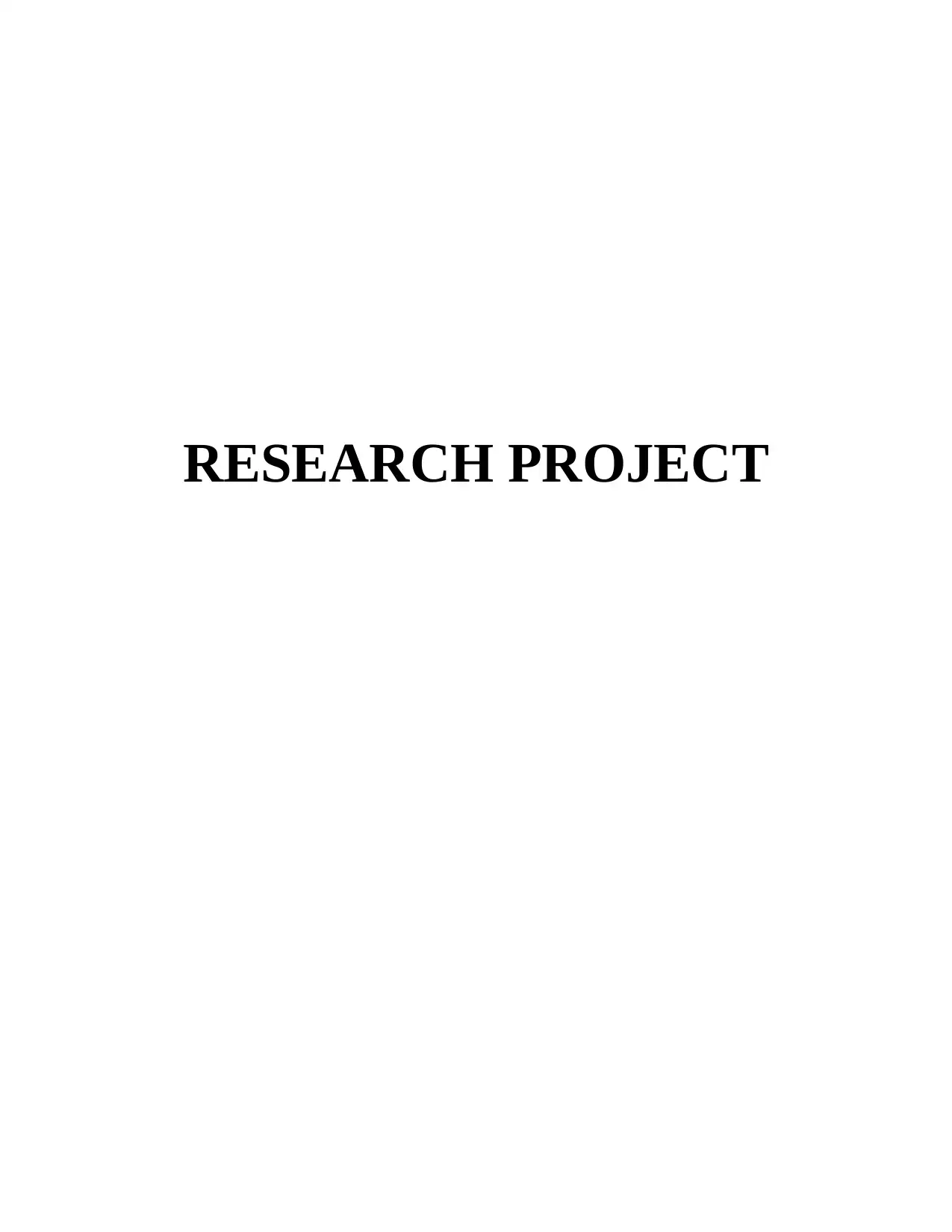
RESEARCH PROJECT
Secure Best Marks with AI Grader
Need help grading? Try our AI Grader for instant feedback on your assignments.
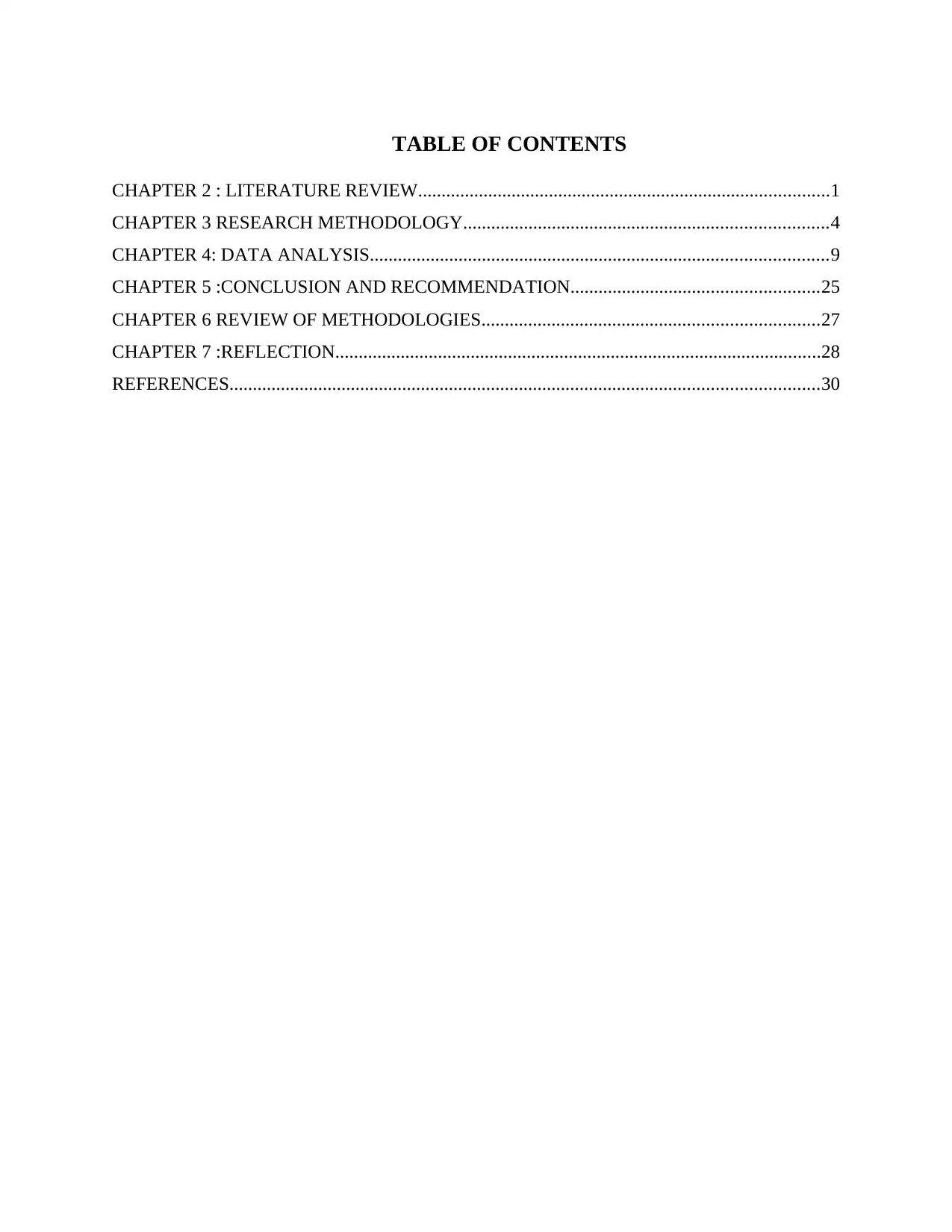
TABLE OF CONTENTS
CHAPTER 2 : LITERATURE REVIEW........................................................................................1
CHAPTER 3 RESEARCH METHODOLOGY..............................................................................4
CHAPTER 4: DATA ANALYSIS..................................................................................................9
CHAPTER 5 :CONCLUSION AND RECOMMENDATION.....................................................25
CHAPTER 6 REVIEW OF METHODOLOGIES........................................................................27
CHAPTER 7 :REFLECTION........................................................................................................28
REFERENCES..............................................................................................................................30
CHAPTER 2 : LITERATURE REVIEW........................................................................................1
CHAPTER 3 RESEARCH METHODOLOGY..............................................................................4
CHAPTER 4: DATA ANALYSIS..................................................................................................9
CHAPTER 5 :CONCLUSION AND RECOMMENDATION.....................................................25
CHAPTER 6 REVIEW OF METHODOLOGIES........................................................................27
CHAPTER 7 :REFLECTION........................................................................................................28
REFERENCES..............................................................................................................................30

CHAPTER 1 INTRODUCTION
Tourism industry is analysed as major industry which has achieved high growth and
innovation in the case study. It is plays an important role in increasing growth and development
of economy by attracting large number of visitors. After increase of international visitors arrival
in UK, there are various important steps have been taken by tourist authorities to improve the
facilities and tourist attractions. These tourist attractions are analysed as those places whicj
directly influence the visitors to arrive and stay at tourist destination. Statitics of world tourism
report provide clear information, current trends and development in tour operations industry have
increased the growth and number of international immigrants in UK . There are various tourist
destination in country that widely attracts visitors and other patients from different countries.
Highly effective and important tourist destinations tends to provide major influence on
perception of customers. Great influence have been occurred in the field of study and for
investigation of those trends and development study is carried out researcher. In this research
project, researcher has conducted analysis on top tourist attraction in London from the
perspective of international visitors.
Aim:
“To evaluate the Top London tourist attraction from the perspective of recent immigrates; Study
on London eye”.
Objective:
To examine top tourist attraction of London; the London Eye.
To evaluate the consumer's feedback on London eye as tourist destination.
To suggest ways to attract more visitors towards the London eye.
Research questions
Is London eye tourist attraction really the best capital has to offer?
Are customers giving positive feedback for the London eye?
CHAPTER 2 : LITERATURE REVIEW
Effects of Tourism
The author Gee (1989) have stated that tourism has both posivite asa well as negative
effect. As per the opinion of Gilbert and Wanhill, (1993) who stated that any form of industrial
development brings with it impacts upon social and physical environment.The author John
(1992) has stated that tourism activity have impact on economy, society as well as environment.
1
Tourism industry is analysed as major industry which has achieved high growth and
innovation in the case study. It is plays an important role in increasing growth and development
of economy by attracting large number of visitors. After increase of international visitors arrival
in UK, there are various important steps have been taken by tourist authorities to improve the
facilities and tourist attractions. These tourist attractions are analysed as those places whicj
directly influence the visitors to arrive and stay at tourist destination. Statitics of world tourism
report provide clear information, current trends and development in tour operations industry have
increased the growth and number of international immigrants in UK . There are various tourist
destination in country that widely attracts visitors and other patients from different countries.
Highly effective and important tourist destinations tends to provide major influence on
perception of customers. Great influence have been occurred in the field of study and for
investigation of those trends and development study is carried out researcher. In this research
project, researcher has conducted analysis on top tourist attraction in London from the
perspective of international visitors.
Aim:
“To evaluate the Top London tourist attraction from the perspective of recent immigrates; Study
on London eye”.
Objective:
To examine top tourist attraction of London; the London Eye.
To evaluate the consumer's feedback on London eye as tourist destination.
To suggest ways to attract more visitors towards the London eye.
Research questions
Is London eye tourist attraction really the best capital has to offer?
Are customers giving positive feedback for the London eye?
CHAPTER 2 : LITERATURE REVIEW
Effects of Tourism
The author Gee (1989) have stated that tourism has both posivite asa well as negative
effect. As per the opinion of Gilbert and Wanhill, (1993) who stated that any form of industrial
development brings with it impacts upon social and physical environment.The author John
(1992) has stated that tourism activity have impact on economy, society as well as environment.
1
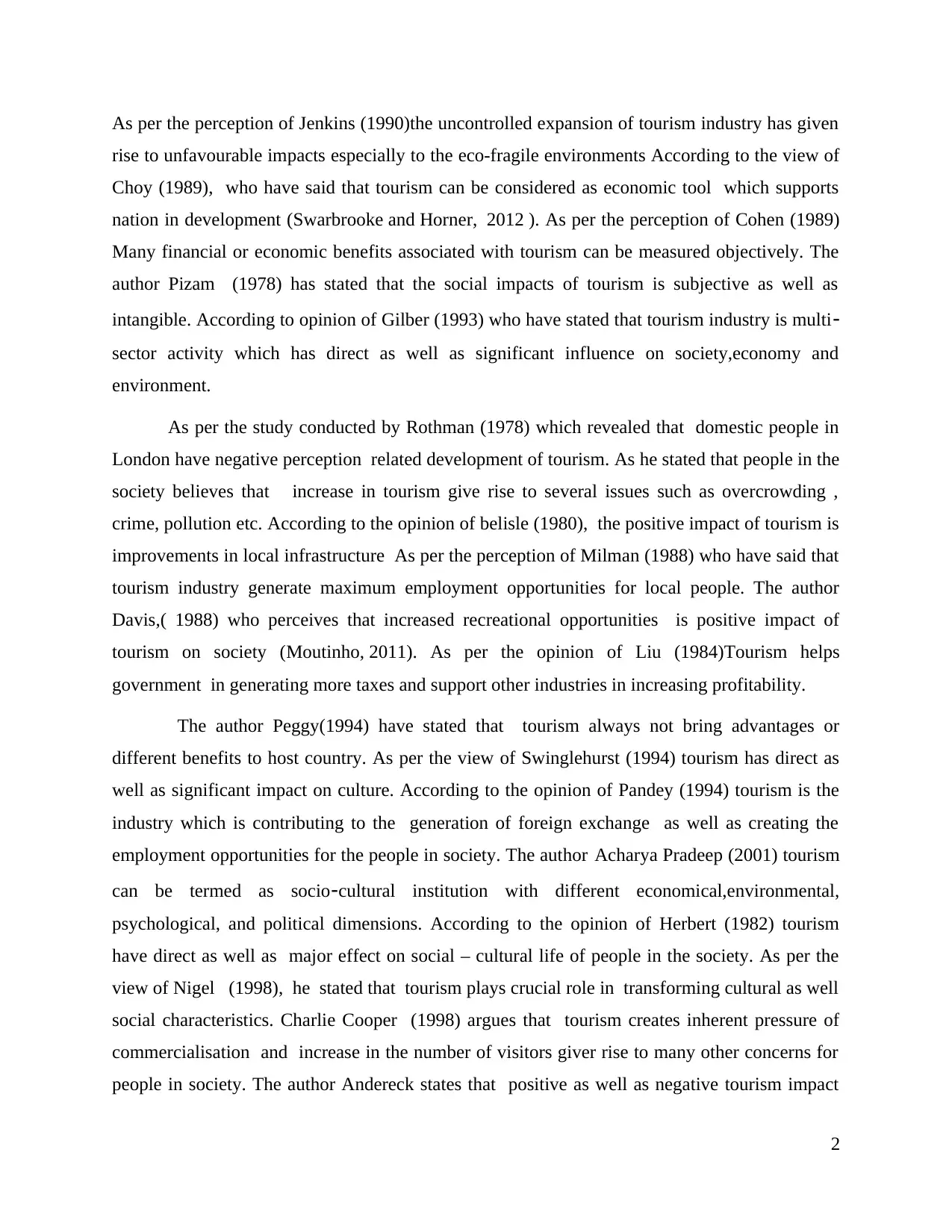
As per the perception of Jenkins (1990)the uncontrolled expansion of tourism industry has given
rise to unfavourable impacts especially to the eco-fragile environments According to the view of
Choy (1989), who have said that tourism can be considered as economic tool which supports
nation in development (Swarbrooke and Horner, 2012 ). As per the perception of Cohen (1989)
Many financial or economic benefits associated with tourism can be measured objectively. The
author Pizam (1978) has stated that the social impacts of tourism is subjective as well as
intangible. According to opinion of Gilber (1993) who have stated that tourism industry is multi-
sector activity which has direct as well as significant influence on society,economy and
environment.
As per the study conducted by Rothman (1978) which revealed that domestic people in
London have negative perception related development of tourism. As he stated that people in the
society believes that increase in tourism give rise to several issues such as overcrowding ,
crime, pollution etc. According to the opinion of belisle (1980), the positive impact of tourism is
improvements in local infrastructure As per the perception of Milman (1988) who have said that
tourism industry generate maximum employment opportunities for local people. The author
Davis,( 1988) who perceives that increased recreational opportunities is positive impact of
tourism on society (Moutinho, 2011). As per the opinion of Liu (1984)Tourism helps
government in generating more taxes and support other industries in increasing profitability.
The author Peggy(1994) have stated that tourism always not bring advantages or
different benefits to host country. As per the view of Swinglehurst (1994) tourism has direct as
well as significant impact on culture. According to the opinion of Pandey (1994) tourism is the
industry which is contributing to the generation of foreign exchange as well as creating the
employment opportunities for the people in society. The author Acharya Pradeep (2001) tourism
can be termed as socio-cultural institution with different economical,environmental,
psychological, and political dimensions. According to the opinion of Herbert (1982) tourism
have direct as well as major effect on social – cultural life of people in the society. As per the
view of Nigel (1998), he stated that tourism plays crucial role in transforming cultural as well
social characteristics. Charlie Cooper (1998) argues that tourism creates inherent pressure of
commercialisation and increase in the number of visitors giver rise to many other concerns for
people in society. The author Andereck states that positive as well as negative tourism impact
2
rise to unfavourable impacts especially to the eco-fragile environments According to the view of
Choy (1989), who have said that tourism can be considered as economic tool which supports
nation in development (Swarbrooke and Horner, 2012 ). As per the perception of Cohen (1989)
Many financial or economic benefits associated with tourism can be measured objectively. The
author Pizam (1978) has stated that the social impacts of tourism is subjective as well as
intangible. According to opinion of Gilber (1993) who have stated that tourism industry is multi-
sector activity which has direct as well as significant influence on society,economy and
environment.
As per the study conducted by Rothman (1978) which revealed that domestic people in
London have negative perception related development of tourism. As he stated that people in the
society believes that increase in tourism give rise to several issues such as overcrowding ,
crime, pollution etc. According to the opinion of belisle (1980), the positive impact of tourism is
improvements in local infrastructure As per the perception of Milman (1988) who have said that
tourism industry generate maximum employment opportunities for local people. The author
Davis,( 1988) who perceives that increased recreational opportunities is positive impact of
tourism on society (Moutinho, 2011). As per the opinion of Liu (1984)Tourism helps
government in generating more taxes and support other industries in increasing profitability.
The author Peggy(1994) have stated that tourism always not bring advantages or
different benefits to host country. As per the view of Swinglehurst (1994) tourism has direct as
well as significant impact on culture. According to the opinion of Pandey (1994) tourism is the
industry which is contributing to the generation of foreign exchange as well as creating the
employment opportunities for the people in society. The author Acharya Pradeep (2001) tourism
can be termed as socio-cultural institution with different economical,environmental,
psychological, and political dimensions. According to the opinion of Herbert (1982) tourism
have direct as well as major effect on social – cultural life of people in the society. As per the
view of Nigel (1998), he stated that tourism plays crucial role in transforming cultural as well
social characteristics. Charlie Cooper (1998) argues that tourism creates inherent pressure of
commercialisation and increase in the number of visitors giver rise to many other concerns for
people in society. The author Andereck states that positive as well as negative tourism impact
2
Secure Best Marks with AI Grader
Need help grading? Try our AI Grader for instant feedback on your assignments.

has direct influence on level of satisfaction gained by people in the society. According to the
opinion of Vargas-Sanchez (2002) community satisfaction is directly link to perceived positive
effect of tourism. The author Nunkoo (2007) services and conditions are the two factors which
influence people to support tourism. As per the view of Mason (2008) who stated that he impacts
are also very important aspects for tourism planning and management in a destination
(Mehmetoglu, 2014.). According to the perception of Andereck, (2005) impact of tourism are
mainly influenced by different factors such as number of tourist, time , seasonality, etc.
The author Bujosa (2007) have stated that tourism contributes to overall regional
development. As per the view of Vogt (2002) tourism have positive effect on local business.
This sector helps in improving the infrastructure as well as facilities provided to tourist.
According to the opinion of Haralambopoulos (2006) believes that tourism give rise to the
inflation.
As per the perception of Cukier (1994) tourism is the business where an individual can
generate high income as well as profit. According to the view of Ritchie (1978)Tourism also
positively affects the community services and extends the range of leisure activities. The author
García, (2015) the most crucial aspects of tourism, is that tourism activities leads to traffic and
increase in number of visitors give rise to overcrowding at destination
(Christou, Sigala and Gretzel, 2012 ). As per the view of Courtney, (1999) who have stated that
tourism has negative effect on routine life of people in the society. According to the opinion of
Lew (2002) Tourism can also result in increased in serious crime.
As per the view Swarbrooke (1999) who has stated that tourism have major impact on
environment. According to the perception of Williams (1998) characteristics of the destination
influence the impact of tourism. He also stated that tourism has less impact on the destinations
located at urban areas. The author McKercher, (1993) have said that tourism bring resources
which can be further utilised for protecting species. According to the view of Krippendorf,(1987)
seasonality plays significant role in development of tourism (Volo, 2010). As per the opinion of
Musa (2008) the positive effect of tourism is that it lead to the increase in efforts to protect the
natural environment as well as heritage sites.
conflicts between tourists and host
3
opinion of Vargas-Sanchez (2002) community satisfaction is directly link to perceived positive
effect of tourism. The author Nunkoo (2007) services and conditions are the two factors which
influence people to support tourism. As per the view of Mason (2008) who stated that he impacts
are also very important aspects for tourism planning and management in a destination
(Mehmetoglu, 2014.). According to the perception of Andereck, (2005) impact of tourism are
mainly influenced by different factors such as number of tourist, time , seasonality, etc.
The author Bujosa (2007) have stated that tourism contributes to overall regional
development. As per the view of Vogt (2002) tourism have positive effect on local business.
This sector helps in improving the infrastructure as well as facilities provided to tourist.
According to the opinion of Haralambopoulos (2006) believes that tourism give rise to the
inflation.
As per the perception of Cukier (1994) tourism is the business where an individual can
generate high income as well as profit. According to the view of Ritchie (1978)Tourism also
positively affects the community services and extends the range of leisure activities. The author
García, (2015) the most crucial aspects of tourism, is that tourism activities leads to traffic and
increase in number of visitors give rise to overcrowding at destination
(Christou, Sigala and Gretzel, 2012 ). As per the view of Courtney, (1999) who have stated that
tourism has negative effect on routine life of people in the society. According to the opinion of
Lew (2002) Tourism can also result in increased in serious crime.
As per the view Swarbrooke (1999) who has stated that tourism have major impact on
environment. According to the perception of Williams (1998) characteristics of the destination
influence the impact of tourism. He also stated that tourism has less impact on the destinations
located at urban areas. The author McKercher, (1993) have said that tourism bring resources
which can be further utilised for protecting species. According to the view of Krippendorf,(1987)
seasonality plays significant role in development of tourism (Volo, 2010). As per the opinion of
Musa (2008) the positive effect of tourism is that it lead to the increase in efforts to protect the
natural environment as well as heritage sites.
conflicts between tourists and host
3
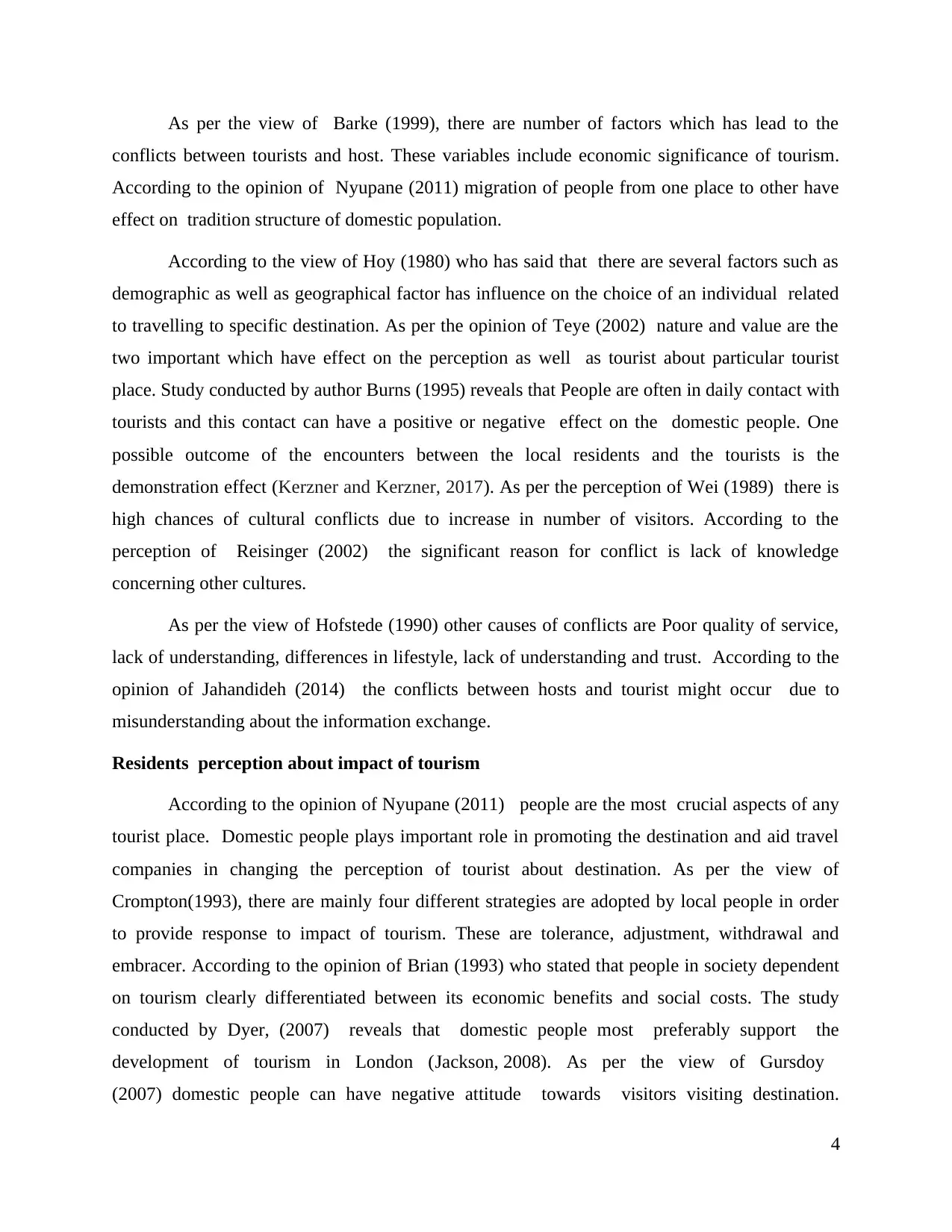
As per the view of Barke (1999), there are number of factors which has lead to the
conflicts between tourists and host. These variables include economic significance of tourism.
According to the opinion of Nyupane (2011) migration of people from one place to other have
effect on tradition structure of domestic population.
According to the view of Hoy (1980) who has said that there are several factors such as
demographic as well as geographical factor has influence on the choice of an individual related
to travelling to specific destination. As per the opinion of Teye (2002) nature and value are the
two important which have effect on the perception as well as tourist about particular tourist
place. Study conducted by author Burns (1995) reveals that People are often in daily contact with
tourists and this contact can have a positive or negative effect on the domestic people. One
possible outcome of the encounters between the local residents and the tourists is the
demonstration effect (Kerzner and Kerzner, 2017). As per the perception of Wei (1989) there is
high chances of cultural conflicts due to increase in number of visitors. According to the
perception of Reisinger (2002) the significant reason for conflict is lack of knowledge
concerning other cultures.
As per the view of Hofstede (1990) other causes of conflicts are Poor quality of service,
lack of understanding, differences in lifestyle, lack of understanding and trust. According to the
opinion of Jahandideh (2014) the conflicts between hosts and tourist might occur due to
misunderstanding about the information exchange.
Residents perception about impact of tourism
According to the opinion of Nyupane (2011) people are the most crucial aspects of any
tourist place. Domestic people plays important role in promoting the destination and aid travel
companies in changing the perception of tourist about destination. As per the view of
Crompton(1993), there are mainly four different strategies are adopted by local people in order
to provide response to impact of tourism. These are tolerance, adjustment, withdrawal and
embracer. According to the opinion of Brian (1993) who stated that people in society dependent
on tourism clearly differentiated between its economic benefits and social costs. The study
conducted by Dyer, (2007) reveals that domestic people most preferably support the
development of tourism in London (Jackson, 2008). As per the view of Gursdoy
(2007) domestic people can have negative attitude towards visitors visiting destination.
4
conflicts between tourists and host. These variables include economic significance of tourism.
According to the opinion of Nyupane (2011) migration of people from one place to other have
effect on tradition structure of domestic population.
According to the view of Hoy (1980) who has said that there are several factors such as
demographic as well as geographical factor has influence on the choice of an individual related
to travelling to specific destination. As per the opinion of Teye (2002) nature and value are the
two important which have effect on the perception as well as tourist about particular tourist
place. Study conducted by author Burns (1995) reveals that People are often in daily contact with
tourists and this contact can have a positive or negative effect on the domestic people. One
possible outcome of the encounters between the local residents and the tourists is the
demonstration effect (Kerzner and Kerzner, 2017). As per the perception of Wei (1989) there is
high chances of cultural conflicts due to increase in number of visitors. According to the
perception of Reisinger (2002) the significant reason for conflict is lack of knowledge
concerning other cultures.
As per the view of Hofstede (1990) other causes of conflicts are Poor quality of service,
lack of understanding, differences in lifestyle, lack of understanding and trust. According to the
opinion of Jahandideh (2014) the conflicts between hosts and tourist might occur due to
misunderstanding about the information exchange.
Residents perception about impact of tourism
According to the opinion of Nyupane (2011) people are the most crucial aspects of any
tourist place. Domestic people plays important role in promoting the destination and aid travel
companies in changing the perception of tourist about destination. As per the view of
Crompton(1993), there are mainly four different strategies are adopted by local people in order
to provide response to impact of tourism. These are tolerance, adjustment, withdrawal and
embracer. According to the opinion of Brian (1993) who stated that people in society dependent
on tourism clearly differentiated between its economic benefits and social costs. The study
conducted by Dyer, (2007) reveals that domestic people most preferably support the
development of tourism in London (Jackson, 2008). As per the view of Gursdoy
(2007) domestic people can have negative attitude towards visitors visiting destination.
4

According to the opinion of Uysal (2002) who has stated that In tourism, social exchange occurs
on an economic, socio-cultural and environmental level.
The author Jurowski (2004) states that economic benefits encourage domestic people to
support development of tourist and have positive attitude towards visitors. According to the
study conducted by Var (1986) who revealed that resident people have supportive attitude , only
in case when tourism have positive effect on economy, society and environment.
As per the view of Dan (1993) he stated that resident people support development of an
industry, if in case they have trust on companies involved in the procedure. According to the
perception of Turner (2003) degree of power hold by local people has direct as well as
significant effect on growth of tourism in the country.
According to the thinking of Andereck (2007) whether the resident supports' tourism
can be measured in terms of their attitudes as well as perception towards an industry. As per the
view of Neto, (2003), increase in number of visitors globally has led to the recognition of the
requirement of sustainable tourism development (Harrison and Lock, 2017). Study conducted by
author Holden (1995) reveals that residents are not able to purchase the same goods as the
tourists. According to the opinion of Braganza (1983) it is very important for travel companies
is to ensure sustainability, as this will assist tourism industry in gaining support from resident
people in development procedure. As per the opinion of Nozawa, (1992) who said that hosts be
respectful of the guests’ culture,in order influence visitors to make frequent visit at specific
destinations.
CHAPTER 3 RESEARCH METHODOLOGY
Research Methodology
Research methods is refers to as several techniques used by researcher in order to
execute different activities during investigation procedure. It also includes the strategies adopted
by researcher in order to achieve desired aims and objectives. Selection of right method or
technique is very important, as this factor can have negative effect on results. The techniques
used assist researcher in reaching to the conclusion and support researcher in making suitable
decision. Nature and type of research are the two factors which are considered by researcher
while selecting the method for performing research activities (Johnson and Christensen, 2010).
Selection of right method enables researcher to conduct research or survey in systematic manner.
5
on an economic, socio-cultural and environmental level.
The author Jurowski (2004) states that economic benefits encourage domestic people to
support development of tourist and have positive attitude towards visitors. According to the
study conducted by Var (1986) who revealed that resident people have supportive attitude , only
in case when tourism have positive effect on economy, society and environment.
As per the view of Dan (1993) he stated that resident people support development of an
industry, if in case they have trust on companies involved in the procedure. According to the
perception of Turner (2003) degree of power hold by local people has direct as well as
significant effect on growth of tourism in the country.
According to the thinking of Andereck (2007) whether the resident supports' tourism
can be measured in terms of their attitudes as well as perception towards an industry. As per the
view of Neto, (2003), increase in number of visitors globally has led to the recognition of the
requirement of sustainable tourism development (Harrison and Lock, 2017). Study conducted by
author Holden (1995) reveals that residents are not able to purchase the same goods as the
tourists. According to the opinion of Braganza (1983) it is very important for travel companies
is to ensure sustainability, as this will assist tourism industry in gaining support from resident
people in development procedure. As per the opinion of Nozawa, (1992) who said that hosts be
respectful of the guests’ culture,in order influence visitors to make frequent visit at specific
destinations.
CHAPTER 3 RESEARCH METHODOLOGY
Research Methodology
Research methods is refers to as several techniques used by researcher in order to
execute different activities during investigation procedure. It also includes the strategies adopted
by researcher in order to achieve desired aims and objectives. Selection of right method or
technique is very important, as this factor can have negative effect on results. The techniques
used assist researcher in reaching to the conclusion and support researcher in making suitable
decision. Nature and type of research are the two factors which are considered by researcher
while selecting the method for performing research activities (Johnson and Christensen, 2010).
Selection of right method enables researcher to conduct research or survey in systematic manner.
5
Paraphrase This Document
Need a fresh take? Get an instant paraphrase of this document with our AI Paraphraser
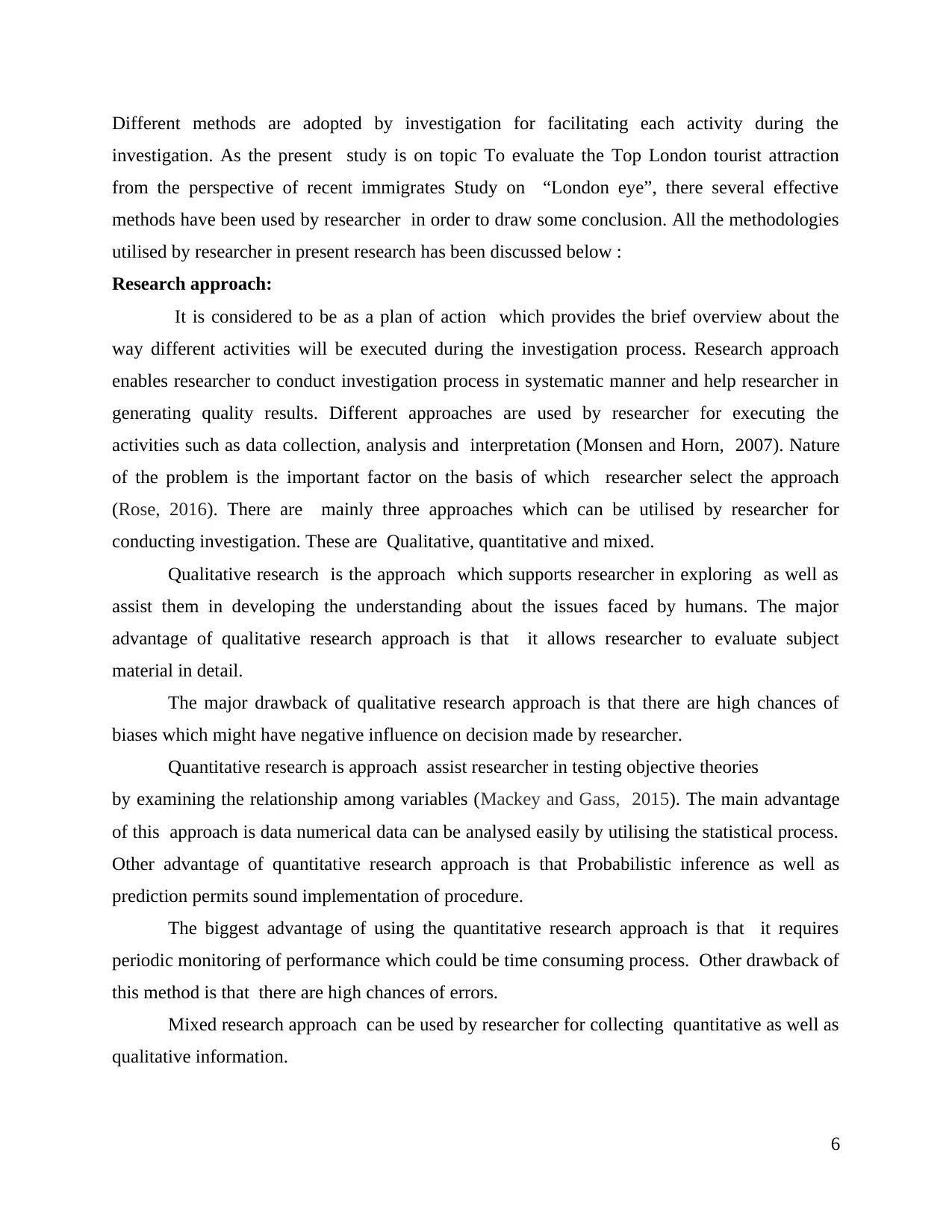
Different methods are adopted by investigation for facilitating each activity during the
investigation. As the present study is on topic To evaluate the Top London tourist attraction
from the perspective of recent immigrates Study on “London eye”, there several effective
methods have been used by researcher in order to draw some conclusion. All the methodologies
utilised by researcher in present research has been discussed below :
Research approach:
It is considered to be as a plan of action which provides the brief overview about the
way different activities will be executed during the investigation process. Research approach
enables researcher to conduct investigation process in systematic manner and help researcher in
generating quality results. Different approaches are used by researcher for executing the
activities such as data collection, analysis and interpretation (Monsen and Horn, 2007). Nature
of the problem is the important factor on the basis of which researcher select the approach
(Rose, 2016). There are mainly three approaches which can be utilised by researcher for
conducting investigation. These are Qualitative, quantitative and mixed.
Qualitative research is the approach which supports researcher in exploring as well as
assist them in developing the understanding about the issues faced by humans. The major
advantage of qualitative research approach is that it allows researcher to evaluate subject
material in detail.
The major drawback of qualitative research approach is that there are high chances of
biases which might have negative influence on decision made by researcher.
Quantitative research is approach assist researcher in testing objective theories
by examining the relationship among variables (Mackey and Gass, 2015). The main advantage
of this approach is data numerical data can be analysed easily by utilising the statistical process.
Other advantage of quantitative research approach is that Probabilistic inference as well as
prediction permits sound implementation of procedure.
The biggest advantage of using the quantitative research approach is that it requires
periodic monitoring of performance which could be time consuming process. Other drawback of
this method is that there are high chances of errors.
Mixed research approach can be used by researcher for collecting quantitative as well as
qualitative information.
6
investigation. As the present study is on topic To evaluate the Top London tourist attraction
from the perspective of recent immigrates Study on “London eye”, there several effective
methods have been used by researcher in order to draw some conclusion. All the methodologies
utilised by researcher in present research has been discussed below :
Research approach:
It is considered to be as a plan of action which provides the brief overview about the
way different activities will be executed during the investigation process. Research approach
enables researcher to conduct investigation process in systematic manner and help researcher in
generating quality results. Different approaches are used by researcher for executing the
activities such as data collection, analysis and interpretation (Monsen and Horn, 2007). Nature
of the problem is the important factor on the basis of which researcher select the approach
(Rose, 2016). There are mainly three approaches which can be utilised by researcher for
conducting investigation. These are Qualitative, quantitative and mixed.
Qualitative research is the approach which supports researcher in exploring as well as
assist them in developing the understanding about the issues faced by humans. The major
advantage of qualitative research approach is that it allows researcher to evaluate subject
material in detail.
The major drawback of qualitative research approach is that there are high chances of
biases which might have negative influence on decision made by researcher.
Quantitative research is approach assist researcher in testing objective theories
by examining the relationship among variables (Mackey and Gass, 2015). The main advantage
of this approach is data numerical data can be analysed easily by utilising the statistical process.
Other advantage of quantitative research approach is that Probabilistic inference as well as
prediction permits sound implementation of procedure.
The biggest advantage of using the quantitative research approach is that it requires
periodic monitoring of performance which could be time consuming process. Other drawback of
this method is that there are high chances of errors.
Mixed research approach can be used by researcher for collecting quantitative as well as
qualitative information.
6
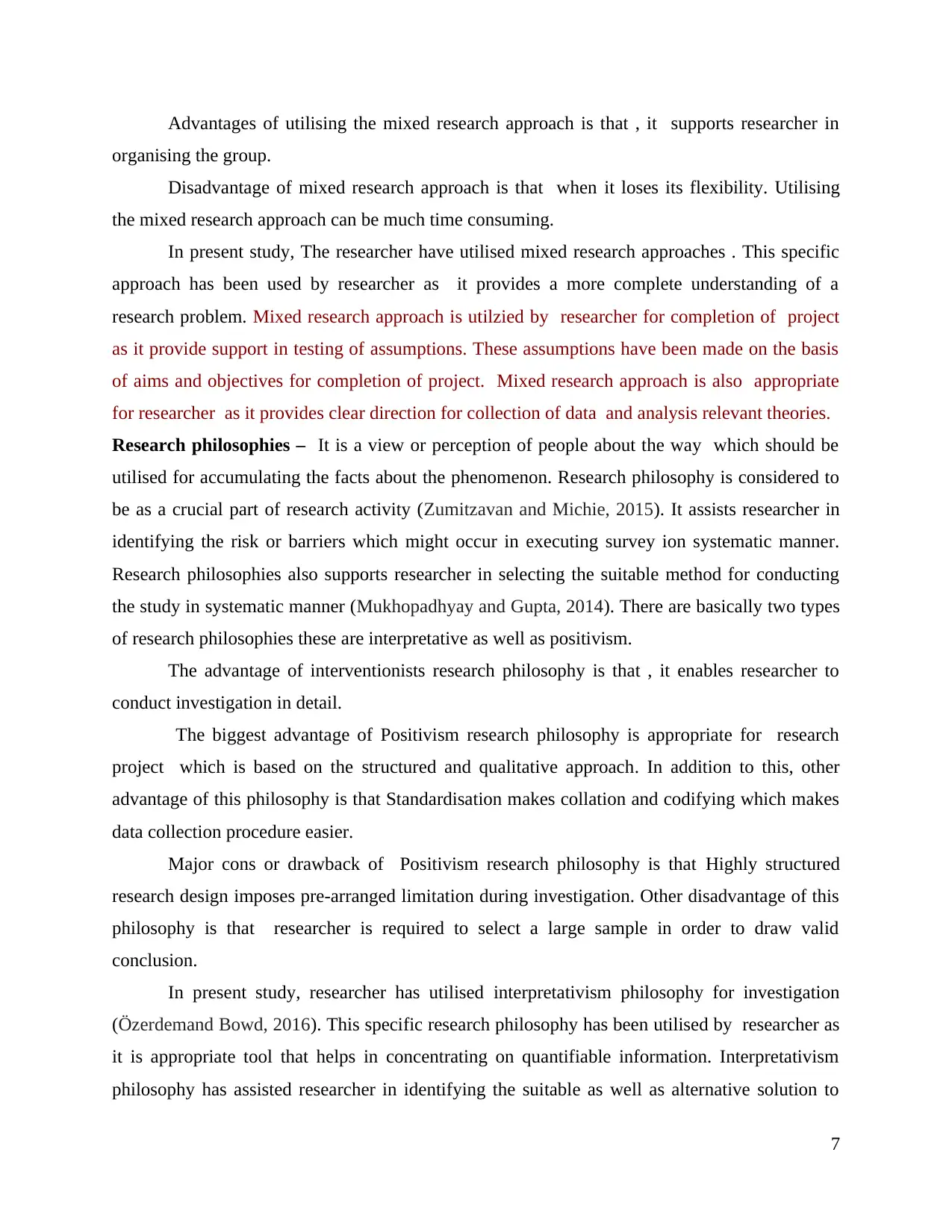
Advantages of utilising the mixed research approach is that , it supports researcher in
organising the group.
Disadvantage of mixed research approach is that when it loses its flexibility. Utilising
the mixed research approach can be much time consuming.
In present study, The researcher have utilised mixed research approaches . This specific
approach has been used by researcher as it provides a more complete understanding of a
research problem. Mixed research approach is utilzied by researcher for completion of project
as it provide support in testing of assumptions. These assumptions have been made on the basis
of aims and objectives for completion of project. Mixed research approach is also appropriate
for researcher as it provides clear direction for collection of data and analysis relevant theories.
Research philosophies – It is a view or perception of people about the way which should be
utilised for accumulating the facts about the phenomenon. Research philosophy is considered to
be as a crucial part of research activity (Zumitzavan and Michie, 2015). It assists researcher in
identifying the risk or barriers which might occur in executing survey ion systematic manner.
Research philosophies also supports researcher in selecting the suitable method for conducting
the study in systematic manner (Mukhopadhyay and Gupta, 2014). There are basically two types
of research philosophies these are interpretative as well as positivism.
The advantage of interventionists research philosophy is that , it enables researcher to
conduct investigation in detail.
The biggest advantage of Positivism research philosophy is appropriate for research
project which is based on the structured and qualitative approach. In addition to this, other
advantage of this philosophy is that Standardisation makes collation and codifying which makes
data collection procedure easier.
Major cons or drawback of Positivism research philosophy is that Highly structured
research design imposes pre-arranged limitation during investigation. Other disadvantage of this
philosophy is that researcher is required to select a large sample in order to draw valid
conclusion.
In present study, researcher has utilised interpretativism philosophy for investigation
(Özerdemand Bowd, 2016). This specific research philosophy has been utilised by researcher as
it is appropriate tool that helps in concentrating on quantifiable information. Interpretativism
philosophy has assisted researcher in identifying the suitable as well as alternative solution to
7
organising the group.
Disadvantage of mixed research approach is that when it loses its flexibility. Utilising
the mixed research approach can be much time consuming.
In present study, The researcher have utilised mixed research approaches . This specific
approach has been used by researcher as it provides a more complete understanding of a
research problem. Mixed research approach is utilzied by researcher for completion of project
as it provide support in testing of assumptions. These assumptions have been made on the basis
of aims and objectives for completion of project. Mixed research approach is also appropriate
for researcher as it provides clear direction for collection of data and analysis relevant theories.
Research philosophies – It is a view or perception of people about the way which should be
utilised for accumulating the facts about the phenomenon. Research philosophy is considered to
be as a crucial part of research activity (Zumitzavan and Michie, 2015). It assists researcher in
identifying the risk or barriers which might occur in executing survey ion systematic manner.
Research philosophies also supports researcher in selecting the suitable method for conducting
the study in systematic manner (Mukhopadhyay and Gupta, 2014). There are basically two types
of research philosophies these are interpretative as well as positivism.
The advantage of interventionists research philosophy is that , it enables researcher to
conduct investigation in detail.
The biggest advantage of Positivism research philosophy is appropriate for research
project which is based on the structured and qualitative approach. In addition to this, other
advantage of this philosophy is that Standardisation makes collation and codifying which makes
data collection procedure easier.
Major cons or drawback of Positivism research philosophy is that Highly structured
research design imposes pre-arranged limitation during investigation. Other disadvantage of this
philosophy is that researcher is required to select a large sample in order to draw valid
conclusion.
In present study, researcher has utilised interpretativism philosophy for investigation
(Özerdemand Bowd, 2016). This specific research philosophy has been utilised by researcher as
it is appropriate tool that helps in concentrating on quantifiable information. Interpretativism
philosophy has assisted researcher in identifying the suitable as well as alternative solution to
7
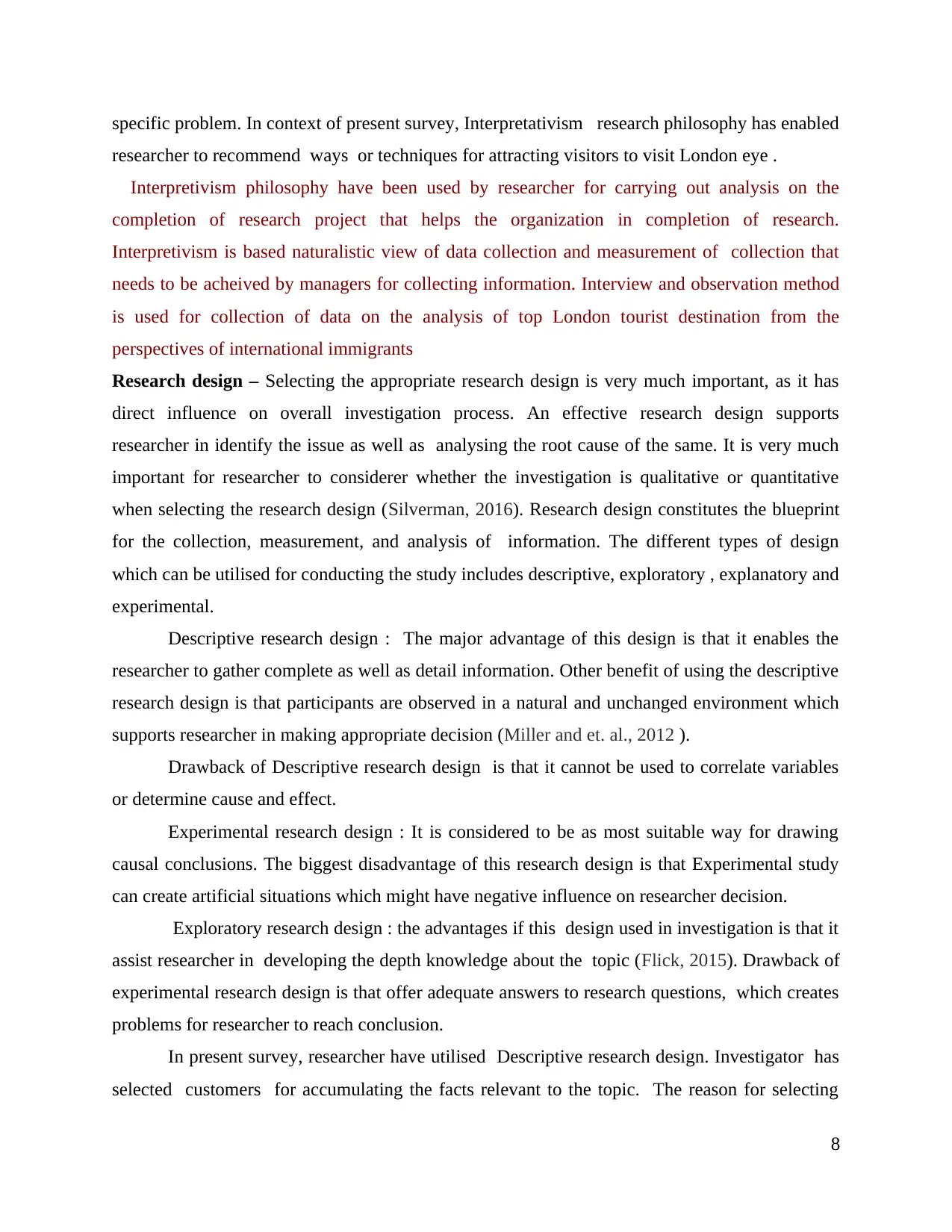
specific problem. In context of present survey, Interpretativism research philosophy has enabled
researcher to recommend ways or techniques for attracting visitors to visit London eye .
Interpretivism philosophy have been used by researcher for carrying out analysis on the
completion of research project that helps the organization in completion of research.
Interpretivism is based naturalistic view of data collection and measurement of collection that
needs to be acheived by managers for collecting information. Interview and observation method
is used for collection of data on the analysis of top London tourist destination from the
perspectives of international immigrants
Research design – Selecting the appropriate research design is very much important, as it has
direct influence on overall investigation process. An effective research design supports
researcher in identify the issue as well as analysing the root cause of the same. It is very much
important for researcher to considerer whether the investigation is qualitative or quantitative
when selecting the research design (Silverman, 2016). Research design constitutes the blueprint
for the collection, measurement, and analysis of information. The different types of design
which can be utilised for conducting the study includes descriptive, exploratory , explanatory and
experimental.
Descriptive research design : The major advantage of this design is that it enables the
researcher to gather complete as well as detail information. Other benefit of using the descriptive
research design is that participants are observed in a natural and unchanged environment which
supports researcher in making appropriate decision (Miller and et. al., 2012 ).
Drawback of Descriptive research design is that it cannot be used to correlate variables
or determine cause and effect.
Experimental research design : It is considered to be as most suitable way for drawing
causal conclusions. The biggest disadvantage of this research design is that Experimental study
can create artificial situations which might have negative influence on researcher decision.
Exploratory research design : the advantages if this design used in investigation is that it
assist researcher in developing the depth knowledge about the topic (Flick, 2015). Drawback of
experimental research design is that offer adequate answers to research questions, which creates
problems for researcher to reach conclusion.
In present survey, researcher have utilised Descriptive research design. Investigator has
selected customers for accumulating the facts relevant to the topic. The reason for selecting
8
researcher to recommend ways or techniques for attracting visitors to visit London eye .
Interpretivism philosophy have been used by researcher for carrying out analysis on the
completion of research project that helps the organization in completion of research.
Interpretivism is based naturalistic view of data collection and measurement of collection that
needs to be acheived by managers for collecting information. Interview and observation method
is used for collection of data on the analysis of top London tourist destination from the
perspectives of international immigrants
Research design – Selecting the appropriate research design is very much important, as it has
direct influence on overall investigation process. An effective research design supports
researcher in identify the issue as well as analysing the root cause of the same. It is very much
important for researcher to considerer whether the investigation is qualitative or quantitative
when selecting the research design (Silverman, 2016). Research design constitutes the blueprint
for the collection, measurement, and analysis of information. The different types of design
which can be utilised for conducting the study includes descriptive, exploratory , explanatory and
experimental.
Descriptive research design : The major advantage of this design is that it enables the
researcher to gather complete as well as detail information. Other benefit of using the descriptive
research design is that participants are observed in a natural and unchanged environment which
supports researcher in making appropriate decision (Miller and et. al., 2012 ).
Drawback of Descriptive research design is that it cannot be used to correlate variables
or determine cause and effect.
Experimental research design : It is considered to be as most suitable way for drawing
causal conclusions. The biggest disadvantage of this research design is that Experimental study
can create artificial situations which might have negative influence on researcher decision.
Exploratory research design : the advantages if this design used in investigation is that it
assist researcher in developing the depth knowledge about the topic (Flick, 2015). Drawback of
experimental research design is that offer adequate answers to research questions, which creates
problems for researcher to reach conclusion.
In present survey, researcher have utilised Descriptive research design. Investigator has
selected customers for accumulating the facts relevant to the topic. The reason for selecting
8
Secure Best Marks with AI Grader
Need help grading? Try our AI Grader for instant feedback on your assignments.

descriptive research design is that , with the support of this method researcher has able to gather
detail information which has assisted him in identifying the issue.
Descriptive research design is utilized by researcher in this to carry out analysis on top
London tourist destination with the perspective of London Eye. These important measures enable
the organization to attract various visitors. These important measures have been undertaken to
carry out research in appropriate manner. It helps in collection of information from secondary
sources and provide complete analysis about theories relevant to the study.
Method of data collection
It is the most important activity in which researcher have to concentrate on the quality of
data gathered. As decision of researcher is completely based on the facts collected during the
investigation. There are two method which can be utilised by researcher for accumulating the
facts relevant to research topic. These are Primary as well as secondary method.
The advantage of utilising primary data collection methodology is that it can be used for
gathering both qualitative as well as quantitative data. Other advantage of primary data
collection method is that there is high reliability of information gathered (Taylor, Bogdan and
DeVault, 2015). The Biggest drawback of primary data collection is that it is time
consuming.Information gathered using secondary method can be biasses. Advantage of utilising
Secondary data collection method is that it saves time which can be used for performing other
research activities.
In present investigation questionnaire as well as face to face interview technique has been
used by researcher for collecting data. This methodology has been selected in order to ensure
reliableness of data. In addition to this, books , journal, magazine have been utilised as the source
of secondary method for accumulating facts. This technique have been used in order to gain in
depth knowledge about topic, so that suitable decision can be made.
Both the primary and secondary method of data collection is used by researcher for collecting
information relevant to the study on top tourist destination in London that affects the business
operations. Questionnaire is framed on the basis of aims and objectives answer research
questions. These important research question the management in completion of research.
Questionnaire provide support in conducting survey of selected sample population whereas
secondary analysis tools involves books, journals and artciles that influence consumers.
9
detail information which has assisted him in identifying the issue.
Descriptive research design is utilized by researcher in this to carry out analysis on top
London tourist destination with the perspective of London Eye. These important measures enable
the organization to attract various visitors. These important measures have been undertaken to
carry out research in appropriate manner. It helps in collection of information from secondary
sources and provide complete analysis about theories relevant to the study.
Method of data collection
It is the most important activity in which researcher have to concentrate on the quality of
data gathered. As decision of researcher is completely based on the facts collected during the
investigation. There are two method which can be utilised by researcher for accumulating the
facts relevant to research topic. These are Primary as well as secondary method.
The advantage of utilising primary data collection methodology is that it can be used for
gathering both qualitative as well as quantitative data. Other advantage of primary data
collection method is that there is high reliability of information gathered (Taylor, Bogdan and
DeVault, 2015). The Biggest drawback of primary data collection is that it is time
consuming.Information gathered using secondary method can be biasses. Advantage of utilising
Secondary data collection method is that it saves time which can be used for performing other
research activities.
In present investigation questionnaire as well as face to face interview technique has been
used by researcher for collecting data. This methodology has been selected in order to ensure
reliableness of data. In addition to this, books , journal, magazine have been utilised as the source
of secondary method for accumulating facts. This technique have been used in order to gain in
depth knowledge about topic, so that suitable decision can be made.
Both the primary and secondary method of data collection is used by researcher for collecting
information relevant to the study on top tourist destination in London that affects the business
operations. Questionnaire is framed on the basis of aims and objectives answer research
questions. These important research question the management in completion of research.
Questionnaire provide support in conducting survey of selected sample population whereas
secondary analysis tools involves books, journals and artciles that influence consumers.
9

Sampling – This is the important part of investigation process. Sampling is the technique which
is generally used by researcher for selecting the few participants from large population.
Effective sampling strategy can assist the researcher in reaching to the final results. It is very
much essential for researcher to select appropriate sampling technique. As this factor have direct
as well as major effect on overall study (Kumar, 2014). There are different types of techniques
which can be utilised by researcher for selecting the participants. These are simple random
sampling, systematic etc.
The advantage of utilizing the simple random sampling is that it assist in eliminating
biasses. Other pros of this sampling technique is that every person has chances to get reselected.
Major drawback of simple random sampling is that there are high chances of errors.
Systematic random sampling : It enables researcher to ensure that the population is
evenly sampled. It eliminates bias selection.
Disadvantage of systematic random sampling is that Participants might not want to take
part , which might have effect on other procedures or research activities.
In this research, researcher has utilized simple random sampling method for selection of
sample size of population. Logic behind using this method as every individual population will
be provided opportunities to take part in sampling. It is useful for researcher to conduct research
on small sample size. Large sample size helps the scholar in completion of research.
Data analysis- It includes the special procedure executed by researcher in order to access the
most important information. Big data analytics is the another appropriate tool which can be used
by researcher for refining of data (Robson and McCartan, 2016).
Techniques of data analysis have been classified in to two categories such as quantitative
and qualitative. Researcher needs to carry out study on top London tourist destination in
accordance with the case study. These important researchers needs to supports scholar for
completion of research and analysis. Increase in customer preference helps in completion of
research, these essential have been achieved by scholar for completion of research.
In present study, thematic analysis has been used by researcher. This specific technique
has been used by researcher in order to make informational useful as well as easy to understand
by user. This methodology has been selected by researcher considering the nature of research
CHAPTER 4: DATA ANALYSIS
Theme 1: Spending money by customer in London Eye
10
is generally used by researcher for selecting the few participants from large population.
Effective sampling strategy can assist the researcher in reaching to the final results. It is very
much essential for researcher to select appropriate sampling technique. As this factor have direct
as well as major effect on overall study (Kumar, 2014). There are different types of techniques
which can be utilised by researcher for selecting the participants. These are simple random
sampling, systematic etc.
The advantage of utilizing the simple random sampling is that it assist in eliminating
biasses. Other pros of this sampling technique is that every person has chances to get reselected.
Major drawback of simple random sampling is that there are high chances of errors.
Systematic random sampling : It enables researcher to ensure that the population is
evenly sampled. It eliminates bias selection.
Disadvantage of systematic random sampling is that Participants might not want to take
part , which might have effect on other procedures or research activities.
In this research, researcher has utilized simple random sampling method for selection of
sample size of population. Logic behind using this method as every individual population will
be provided opportunities to take part in sampling. It is useful for researcher to conduct research
on small sample size. Large sample size helps the scholar in completion of research.
Data analysis- It includes the special procedure executed by researcher in order to access the
most important information. Big data analytics is the another appropriate tool which can be used
by researcher for refining of data (Robson and McCartan, 2016).
Techniques of data analysis have been classified in to two categories such as quantitative
and qualitative. Researcher needs to carry out study on top London tourist destination in
accordance with the case study. These important researchers needs to supports scholar for
completion of research and analysis. Increase in customer preference helps in completion of
research, these essential have been achieved by scholar for completion of research.
In present study, thematic analysis has been used by researcher. This specific technique
has been used by researcher in order to make informational useful as well as easy to understand
by user. This methodology has been selected by researcher considering the nature of research
CHAPTER 4: DATA ANALYSIS
Theme 1: Spending money by customer in London Eye
10
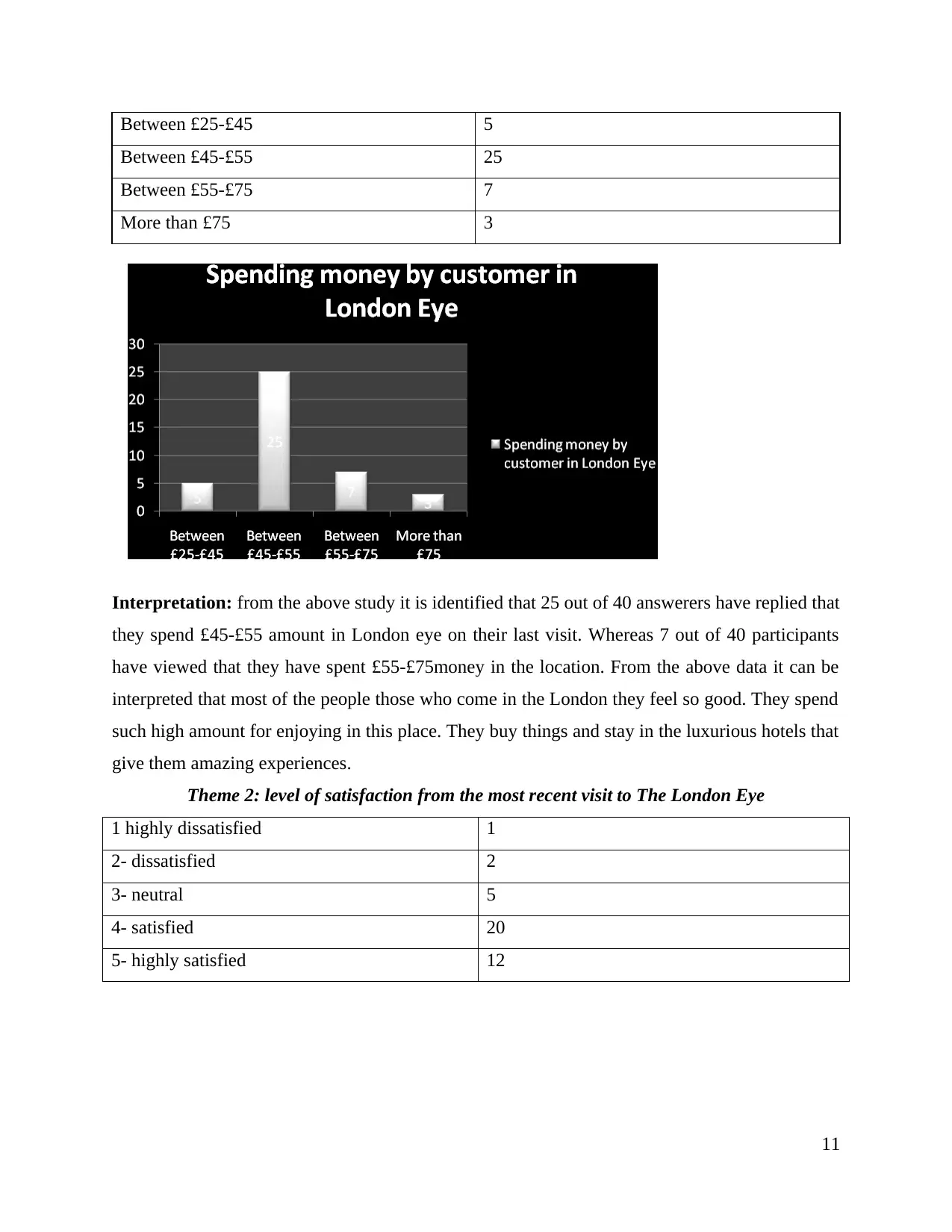
Between £25-£45 5
Between £45-£55 25
Between £55-£75 7
More than £75 3
Interpretation: from the above study it is identified that 25 out of 40 answerers have replied that
they spend £45-£55 amount in London eye on their last visit. Whereas 7 out of 40 participants
have viewed that they have spent £55-£75money in the location. From the above data it can be
interpreted that most of the people those who come in the London they feel so good. They spend
such high amount for enjoying in this place. They buy things and stay in the luxurious hotels that
give them amazing experiences.
Theme 2: level of satisfaction from the most recent visit to The London Eye
1 highly dissatisfied 1
2- dissatisfied 2
3- neutral 5
4- satisfied 20
5- highly satisfied 12
11
Between £45-£55 25
Between £55-£75 7
More than £75 3
Interpretation: from the above study it is identified that 25 out of 40 answerers have replied that
they spend £45-£55 amount in London eye on their last visit. Whereas 7 out of 40 participants
have viewed that they have spent £55-£75money in the location. From the above data it can be
interpreted that most of the people those who come in the London they feel so good. They spend
such high amount for enjoying in this place. They buy things and stay in the luxurious hotels that
give them amazing experiences.
Theme 2: level of satisfaction from the most recent visit to The London Eye
1 highly dissatisfied 1
2- dissatisfied 2
3- neutral 5
4- satisfied 20
5- highly satisfied 12
11
Paraphrase This Document
Need a fresh take? Get an instant paraphrase of this document with our AI Paraphraser
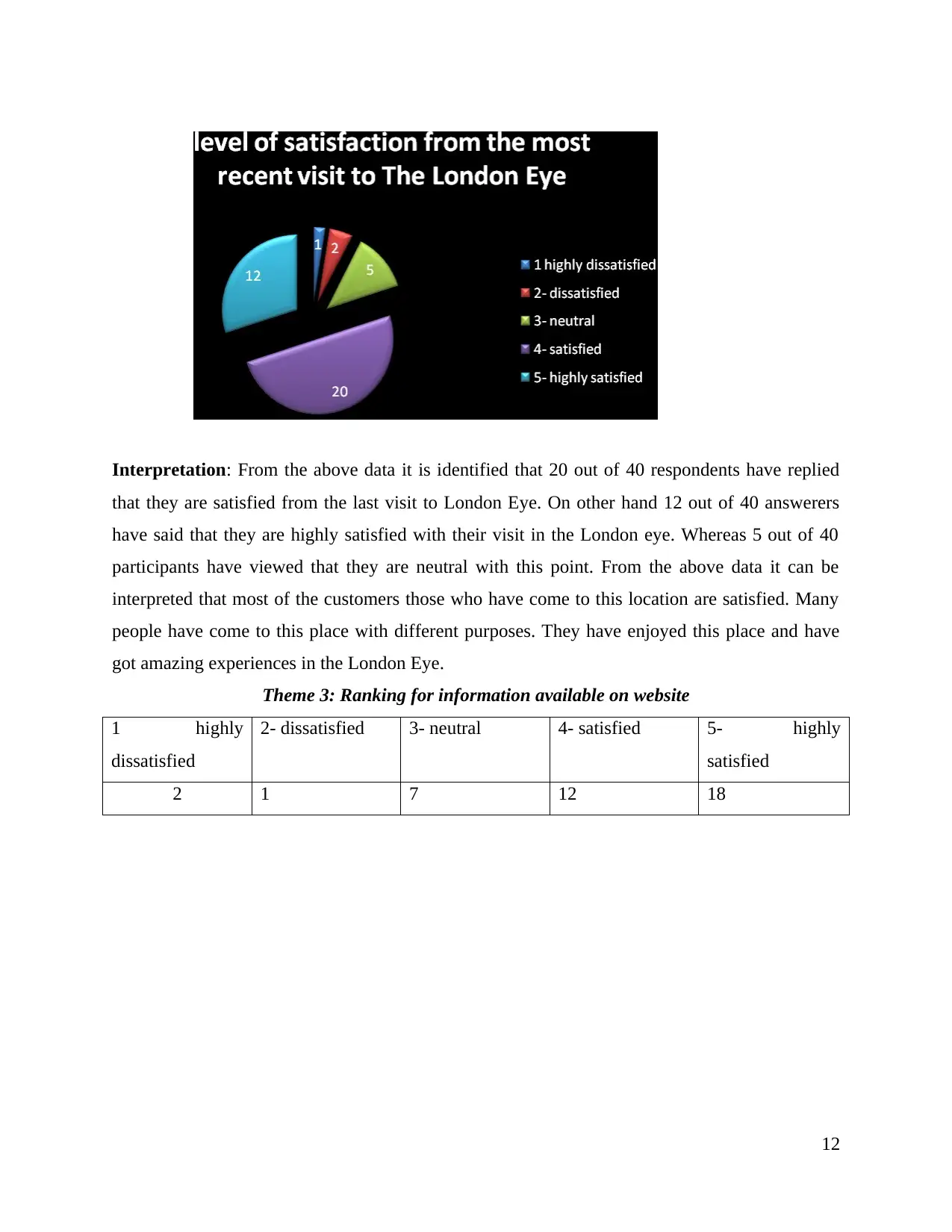
Interpretation: From the above data it is identified that 20 out of 40 respondents have replied
that they are satisfied from the last visit to London Eye. On other hand 12 out of 40 answerers
have said that they are highly satisfied with their visit in the London eye. Whereas 5 out of 40
participants have viewed that they are neutral with this point. From the above data it can be
interpreted that most of the customers those who have come to this location are satisfied. Many
people have come to this place with different purposes. They have enjoyed this place and have
got amazing experiences in the London Eye.
Theme 3: Ranking for information available on website
1 highly
dissatisfied
2- dissatisfied 3- neutral 4- satisfied 5- highly
satisfied
2 1 7 12 18
12
that they are satisfied from the last visit to London Eye. On other hand 12 out of 40 answerers
have said that they are highly satisfied with their visit in the London eye. Whereas 5 out of 40
participants have viewed that they are neutral with this point. From the above data it can be
interpreted that most of the customers those who have come to this location are satisfied. Many
people have come to this place with different purposes. They have enjoyed this place and have
got amazing experiences in the London Eye.
Theme 3: Ranking for information available on website
1 highly
dissatisfied
2- dissatisfied 3- neutral 4- satisfied 5- highly
satisfied
2 1 7 12 18
12
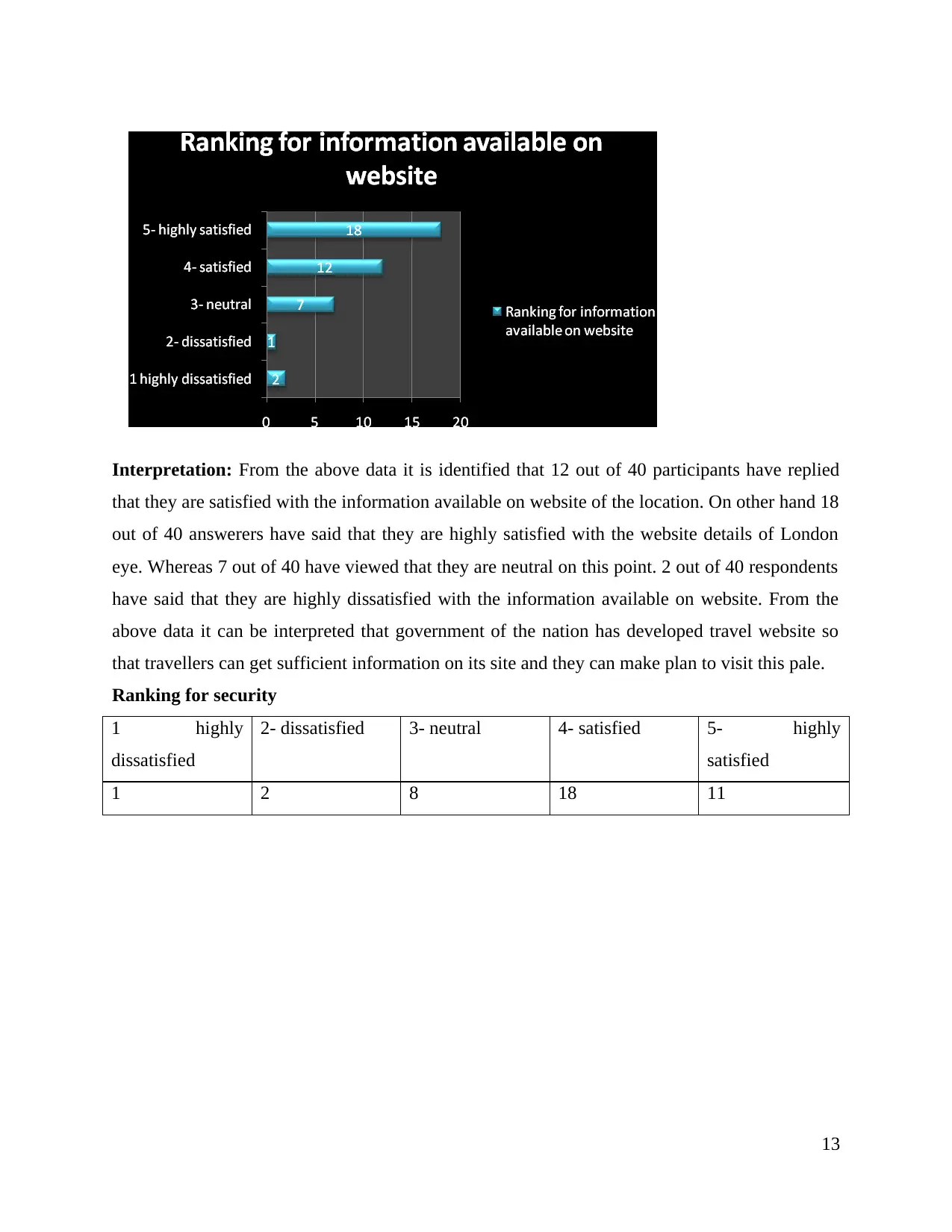
Interpretation: From the above data it is identified that 12 out of 40 participants have replied
that they are satisfied with the information available on website of the location. On other hand 18
out of 40 answerers have said that they are highly satisfied with the website details of London
eye. Whereas 7 out of 40 have viewed that they are neutral on this point. 2 out of 40 respondents
have said that they are highly dissatisfied with the information available on website. From the
above data it can be interpreted that government of the nation has developed travel website so
that travellers can get sufficient information on its site and they can make plan to visit this pale.
Ranking for security
1 highly
dissatisfied
2- dissatisfied 3- neutral 4- satisfied 5- highly
satisfied
1 2 8 18 11
13
that they are satisfied with the information available on website of the location. On other hand 18
out of 40 answerers have said that they are highly satisfied with the website details of London
eye. Whereas 7 out of 40 have viewed that they are neutral on this point. 2 out of 40 respondents
have said that they are highly dissatisfied with the information available on website. From the
above data it can be interpreted that government of the nation has developed travel website so
that travellers can get sufficient information on its site and they can make plan to visit this pale.
Ranking for security
1 highly
dissatisfied
2- dissatisfied 3- neutral 4- satisfied 5- highly
satisfied
1 2 8 18 11
13

Interpretation: From the above data it is identified that 18 out of 40 answerers have replied that
they are satisfied with the security services of the London Eye. On other hand 11 out of 40
participants have said that they are highly satisfied with the security features of the country.
Whereas there are 2 out of 40 participants they have viewed that they are dissatisfied with the
security services of London. From the above data it can be interpreted that there are maximum
people those who are satisfied with the security element of the location. There are proper
facilities of police and there are many police stations near to this attraction point. Thus, people
do not get trouble in this destination.
Ranking for customer inquiries
1 highly
dissatisfied
2- dissatisfied 3- neutral 4- satisfied 5- highly
satisfied
7 11 6 12 4
14
they are satisfied with the security services of the London Eye. On other hand 11 out of 40
participants have said that they are highly satisfied with the security features of the country.
Whereas there are 2 out of 40 participants they have viewed that they are dissatisfied with the
security services of London. From the above data it can be interpreted that there are maximum
people those who are satisfied with the security element of the location. There are proper
facilities of police and there are many police stations near to this attraction point. Thus, people
do not get trouble in this destination.
Ranking for customer inquiries
1 highly
dissatisfied
2- dissatisfied 3- neutral 4- satisfied 5- highly
satisfied
7 11 6 12 4
14
Secure Best Marks with AI Grader
Need help grading? Try our AI Grader for instant feedback on your assignments.
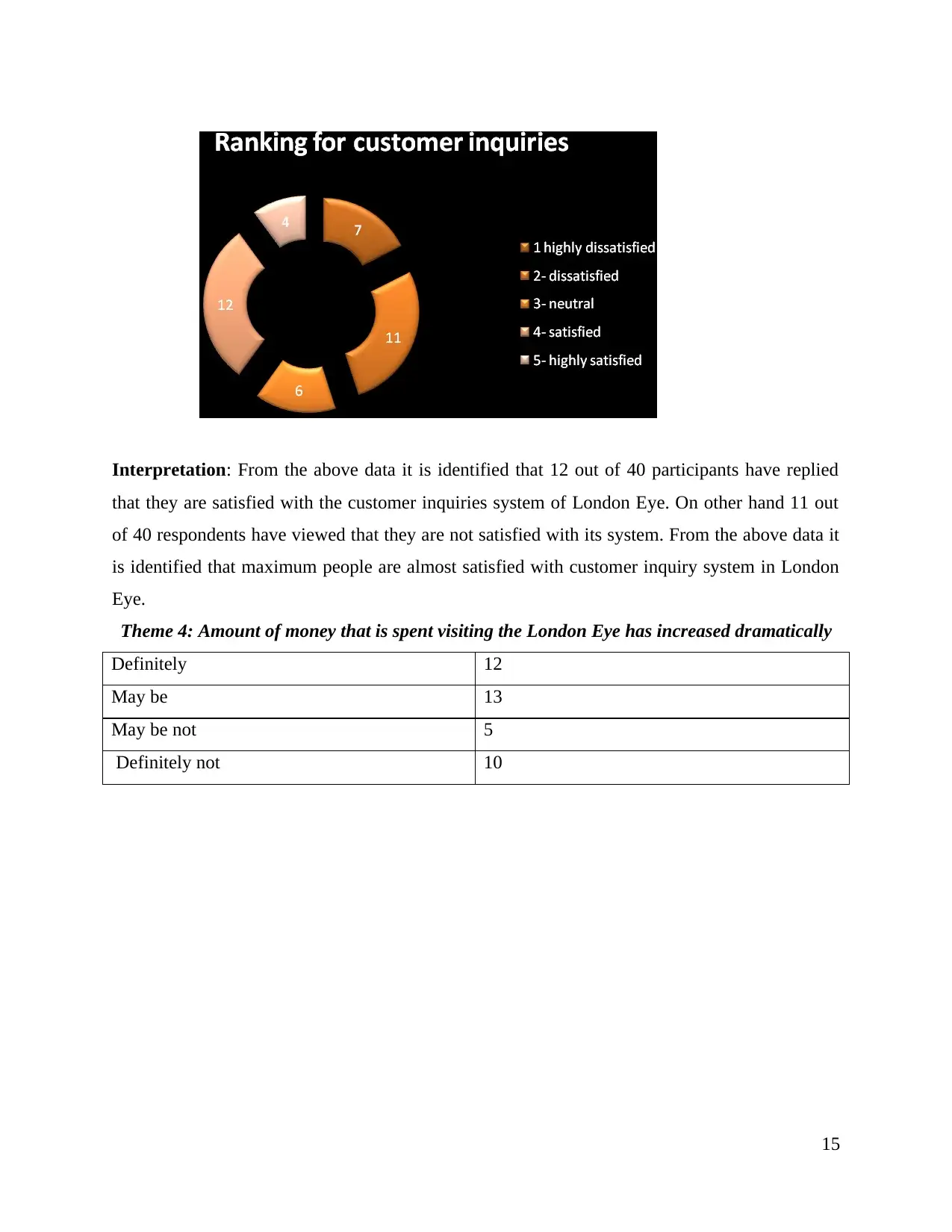
Interpretation: From the above data it is identified that 12 out of 40 participants have replied
that they are satisfied with the customer inquiries system of London Eye. On other hand 11 out
of 40 respondents have viewed that they are not satisfied with its system. From the above data it
is identified that maximum people are almost satisfied with customer inquiry system in London
Eye.
Theme 4: Amount of money that is spent visiting the London Eye has increased dramatically
Definitely 12
May be 13
May be not 5
Definitely not 10
15
that they are satisfied with the customer inquiries system of London Eye. On other hand 11 out
of 40 respondents have viewed that they are not satisfied with its system. From the above data it
is identified that maximum people are almost satisfied with customer inquiry system in London
Eye.
Theme 4: Amount of money that is spent visiting the London Eye has increased dramatically
Definitely 12
May be 13
May be not 5
Definitely not 10
15

Interpretation: From the above data it is identified that 13 out of 40 answerers have replied that
definitely amount of money that is spend by visitors in London eye has been increased.
Theme 5: Visitors like the London Eye as tourist destination
Like 30
Don’t like 10
Interpretation: Questionnaire survey method is utilized by researcher to analyse the consumer's
perception towards tourist destination. From the sample of 40 respondents, selected 30
respondents have clearly stated that they like the London Eye as tourist destination. 10
respondents have stated that they don't like the destination. However, it can be stated that
Visitors like the London eye as tourist destination.
16
definitely amount of money that is spend by visitors in London eye has been increased.
Theme 5: Visitors like the London Eye as tourist destination
Like 30
Don’t like 10
Interpretation: Questionnaire survey method is utilized by researcher to analyse the consumer's
perception towards tourist destination. From the sample of 40 respondents, selected 30
respondents have clearly stated that they like the London Eye as tourist destination. 10
respondents have stated that they don't like the destination. However, it can be stated that
Visitors like the London eye as tourist destination.
16

Theme 6: Got positive feedback for London Eye
Yes 25
No 10
Moderate 5
Interpretation: From the above analysis of 40 respondents, 25 customers have stated “Yes” as
they have got positive feedback for the London Eye as Tourist destination. 10 respondents have
stated “No” because they have not achieved positive feedback for London Eye. 5 respondents
have stated that they have got moderate feedback. Hence, it is clear that customers have got
moderate feedback for London Eye as tourist destination.
Theme 7: that immigrates are getting proper care in tourist destinations.
Agree 15
Disagree 25
17
Yes 25
No 10
Moderate 5
Interpretation: From the above analysis of 40 respondents, 25 customers have stated “Yes” as
they have got positive feedback for the London Eye as Tourist destination. 10 respondents have
stated “No” because they have not achieved positive feedback for London Eye. 5 respondents
have stated that they have got moderate feedback. Hence, it is clear that customers have got
moderate feedback for London Eye as tourist destination.
Theme 7: that immigrates are getting proper care in tourist destinations.
Agree 15
Disagree 25
17
Paraphrase This Document
Need a fresh take? Get an instant paraphrase of this document with our AI Paraphraser

Interpretation: Questionnaire survey method was applied by researcher for completion of
research and getting respondents of customers. From sample of 40 respondents, 15 respondents
are “Agree” that Immigrants are getting the proper care in tourist destination. 25 customers are
“Disagree” with the statement. Hence, it can be interpreted that immigrants are getting proper
care in tourist destinations.
Theme 8: Customers are not satisfied with the travel facilities for immigrates in London Eye
Highly satisfied 5
Not satisfied 25
Rearrange 10
18
research and getting respondents of customers. From sample of 40 respondents, 15 respondents
are “Agree” that Immigrants are getting the proper care in tourist destination. 25 customers are
“Disagree” with the statement. Hence, it can be interpreted that immigrants are getting proper
care in tourist destinations.
Theme 8: Customers are not satisfied with the travel facilities for immigrates in London Eye
Highly satisfied 5
Not satisfied 25
Rearrange 10
18

Analysis and interpretation: Questionnaire analysis method is used by researcher for collecting
information from visitors related to their travelling facilities in London Eye. From the above
analysis, it is highlighted that 5 respondents are highly satisfied with the travel facilities for
immigrants in London Eye. 25 respondents have stated that they are not satisfied with the travel
facilities. 10 visitors are not sure about the statement. In this analysis, it is clear that Visitors are
not satisfied with the travel facilities for immigrants in London Eye. However, it can be stated
that visitors are not satisfied with the travel facilities for immigrants in London Eye.
Theme 9: thing to look at first before planning to be going to any other destination
Political background of the location 5
Security and transportation facility of the
place
15
Attraction points of the place 12
others 8
Interpretation and Analysis: In this research, researcher has utilized Questionnaire as a tool for
gathering data from selected sample size of 40 customers. Customers are selected because they
provide relevant information about London eye. In this analysis, 5 respondents view that
political background of location needs to be considered before planning to be going to another
destination. 15 Respondents have specified that security and transportation facilities are required
to considered. 12 customers have stated attractions are must be identified whereas 8 respondents
are going for other factor. In this analysis, researcher has analysed that security and
19
information from visitors related to their travelling facilities in London Eye. From the above
analysis, it is highlighted that 5 respondents are highly satisfied with the travel facilities for
immigrants in London Eye. 25 respondents have stated that they are not satisfied with the travel
facilities. 10 visitors are not sure about the statement. In this analysis, it is clear that Visitors are
not satisfied with the travel facilities for immigrants in London Eye. However, it can be stated
that visitors are not satisfied with the travel facilities for immigrants in London Eye.
Theme 9: thing to look at first before planning to be going to any other destination
Political background of the location 5
Security and transportation facility of the
place
15
Attraction points of the place 12
others 8
Interpretation and Analysis: In this research, researcher has utilized Questionnaire as a tool for
gathering data from selected sample size of 40 customers. Customers are selected because they
provide relevant information about London eye. In this analysis, 5 respondents view that
political background of location needs to be considered before planning to be going to another
destination. 15 Respondents have specified that security and transportation facilities are required
to considered. 12 customers have stated attractions are must be identified whereas 8 respondents
are going for other factor. In this analysis, researcher has analysed that security and
19
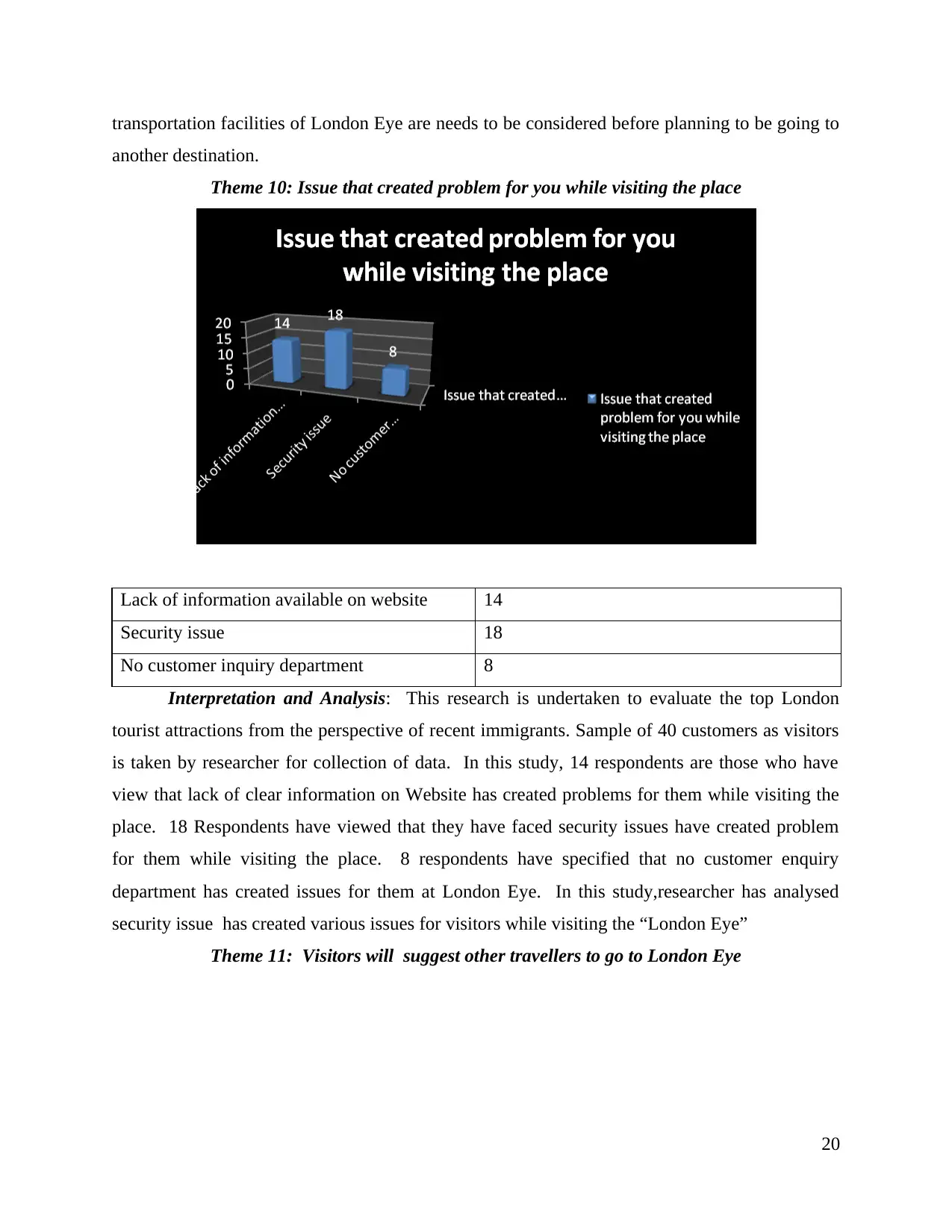
transportation facilities of London Eye are needs to be considered before planning to be going to
another destination.
Theme 10: Issue that created problem for you while visiting the place
Lack of information available on website 14
Security issue 18
No customer inquiry department 8
Interpretation and Analysis: This research is undertaken to evaluate the top London
tourist attractions from the perspective of recent immigrants. Sample of 40 customers as visitors
is taken by researcher for collection of data. In this study, 14 respondents are those who have
view that lack of clear information on Website has created problems for them while visiting the
place. 18 Respondents have viewed that they have faced security issues have created problem
for them while visiting the place. 8 respondents have specified that no customer enquiry
department has created issues for them at London Eye. In this study,researcher has analysed
security issue has created various issues for visitors while visiting the “London Eye”
Theme 11: Visitors will suggest other travellers to go to London Eye
20
another destination.
Theme 10: Issue that created problem for you while visiting the place
Lack of information available on website 14
Security issue 18
No customer inquiry department 8
Interpretation and Analysis: This research is undertaken to evaluate the top London
tourist attractions from the perspective of recent immigrants. Sample of 40 customers as visitors
is taken by researcher for collection of data. In this study, 14 respondents are those who have
view that lack of clear information on Website has created problems for them while visiting the
place. 18 Respondents have viewed that they have faced security issues have created problem
for them while visiting the place. 8 respondents have specified that no customer enquiry
department has created issues for them at London Eye. In this study,researcher has analysed
security issue has created various issues for visitors while visiting the “London Eye”
Theme 11: Visitors will suggest other travellers to go to London Eye
20
Secure Best Marks with AI Grader
Need help grading? Try our AI Grader for instant feedback on your assignments.
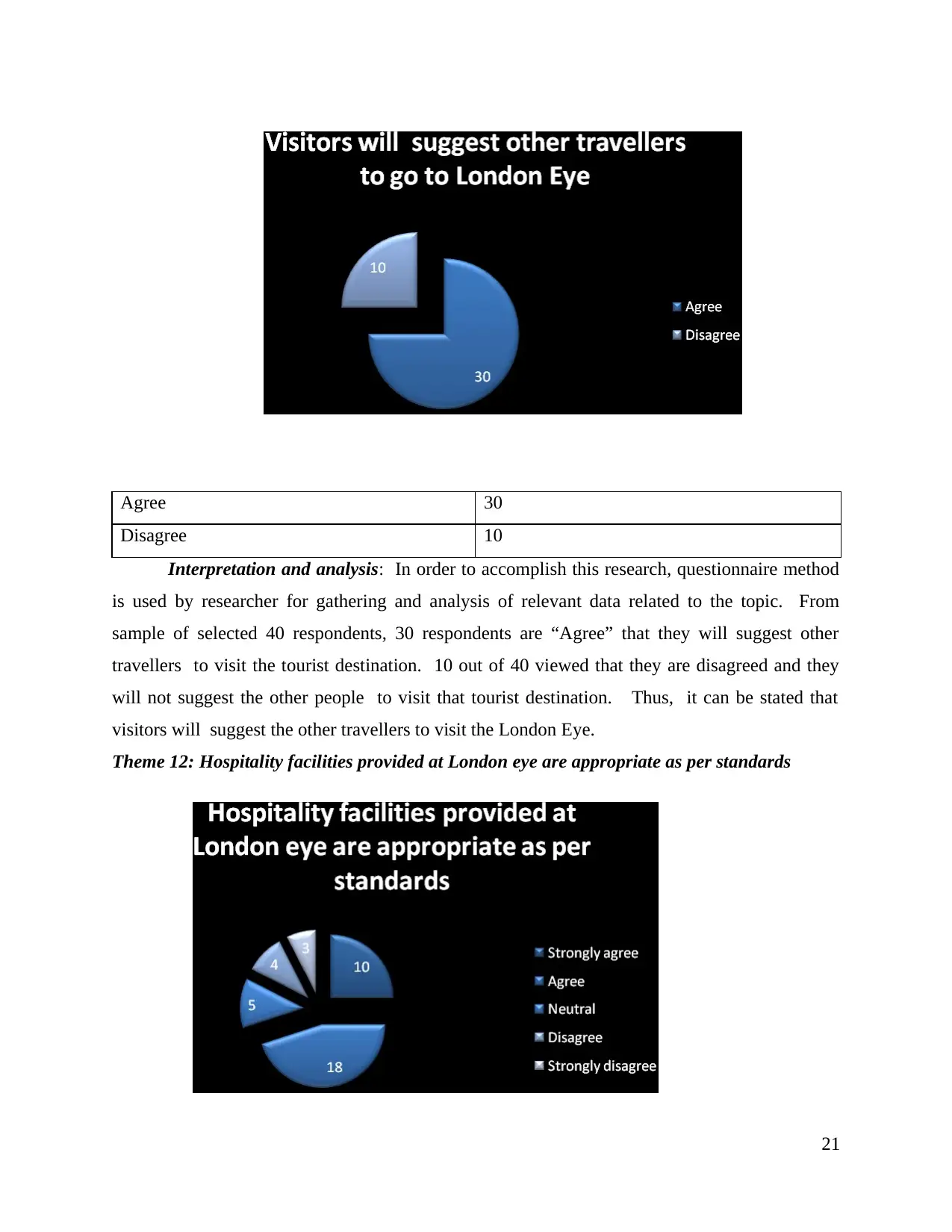
Agree 30
Disagree 10
Interpretation and analysis: In order to accomplish this research, questionnaire method
is used by researcher for gathering and analysis of relevant data related to the topic. From
sample of selected 40 respondents, 30 respondents are “Agree” that they will suggest other
travellers to visit the tourist destination. 10 out of 40 viewed that they are disagreed and they
will not suggest the other people to visit that tourist destination. Thus, it can be stated that
visitors will suggest the other travellers to visit the London Eye.
Theme 12: Hospitality facilities provided at London eye are appropriate as per standards
21
Disagree 10
Interpretation and analysis: In order to accomplish this research, questionnaire method
is used by researcher for gathering and analysis of relevant data related to the topic. From
sample of selected 40 respondents, 30 respondents are “Agree” that they will suggest other
travellers to visit the tourist destination. 10 out of 40 viewed that they are disagreed and they
will not suggest the other people to visit that tourist destination. Thus, it can be stated that
visitors will suggest the other travellers to visit the London Eye.
Theme 12: Hospitality facilities provided at London eye are appropriate as per standards
21
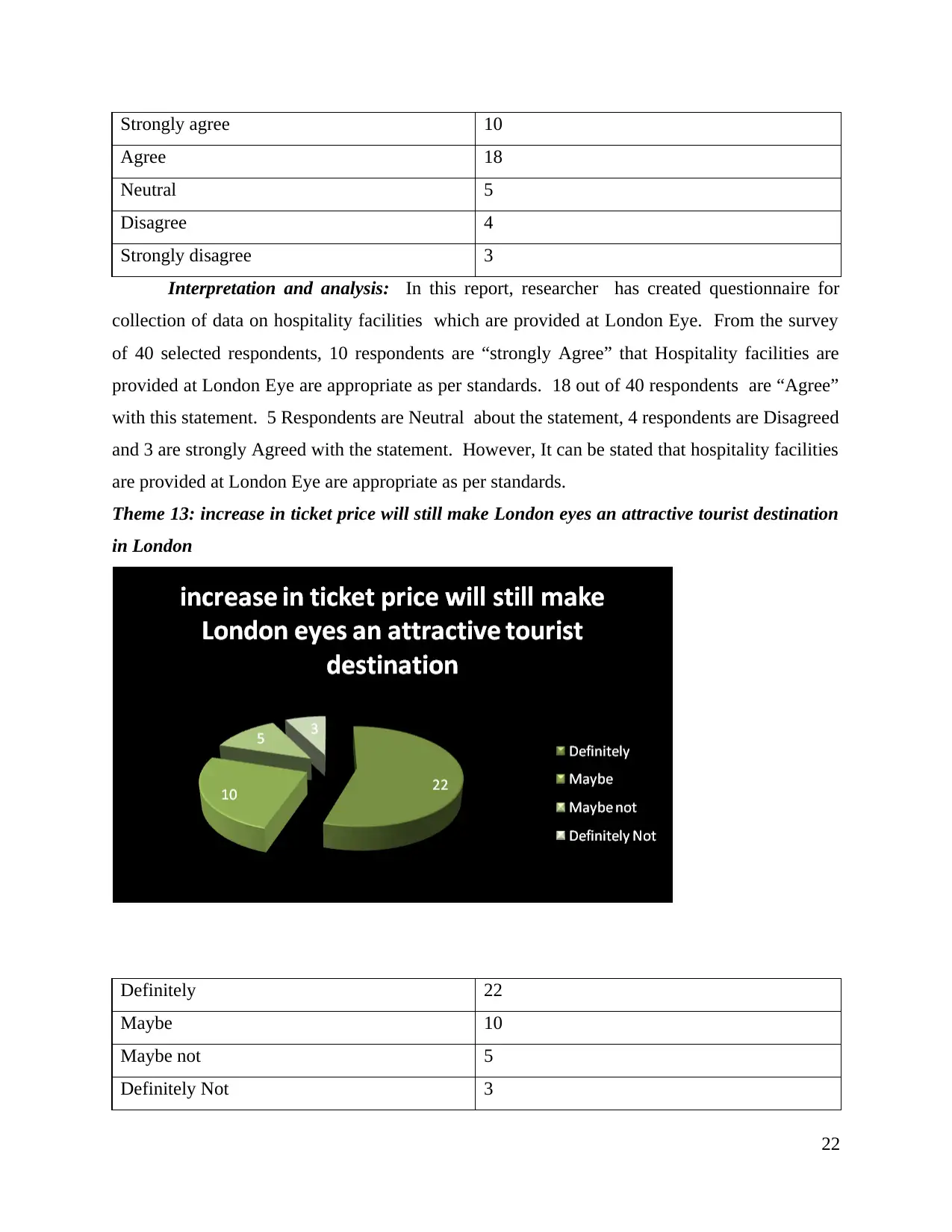
Strongly agree 10
Agree 18
Neutral 5
Disagree 4
Strongly disagree 3
Interpretation and analysis: In this report, researcher has created questionnaire for
collection of data on hospitality facilities which are provided at London Eye. From the survey
of 40 selected respondents, 10 respondents are “strongly Agree” that Hospitality facilities are
provided at London Eye are appropriate as per standards. 18 out of 40 respondents are “Agree”
with this statement. 5 Respondents are Neutral about the statement, 4 respondents are Disagreed
and 3 are strongly Agreed with the statement. However, It can be stated that hospitality facilities
are provided at London Eye are appropriate as per standards.
Theme 13: increase in ticket price will still make London eyes an attractive tourist destination
in London
Definitely 22
Maybe 10
Maybe not 5
Definitely Not 3
22
Agree 18
Neutral 5
Disagree 4
Strongly disagree 3
Interpretation and analysis: In this report, researcher has created questionnaire for
collection of data on hospitality facilities which are provided at London Eye. From the survey
of 40 selected respondents, 10 respondents are “strongly Agree” that Hospitality facilities are
provided at London Eye are appropriate as per standards. 18 out of 40 respondents are “Agree”
with this statement. 5 Respondents are Neutral about the statement, 4 respondents are Disagreed
and 3 are strongly Agreed with the statement. However, It can be stated that hospitality facilities
are provided at London Eye are appropriate as per standards.
Theme 13: increase in ticket price will still make London eyes an attractive tourist destination
in London
Definitely 22
Maybe 10
Maybe not 5
Definitely Not 3
22
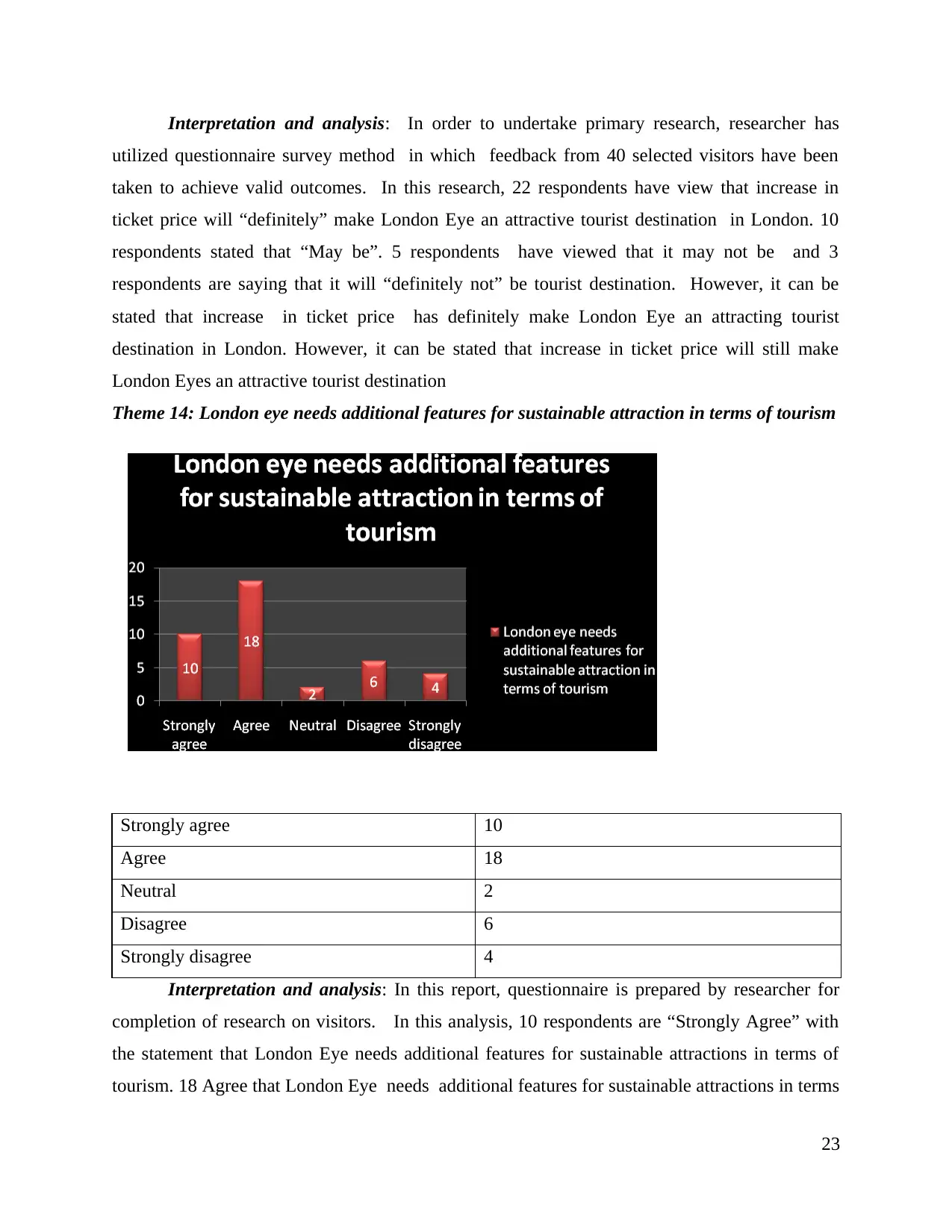
Interpretation and analysis: In order to undertake primary research, researcher has
utilized questionnaire survey method in which feedback from 40 selected visitors have been
taken to achieve valid outcomes. In this research, 22 respondents have view that increase in
ticket price will “definitely” make London Eye an attractive tourist destination in London. 10
respondents stated that “May be”. 5 respondents have viewed that it may not be and 3
respondents are saying that it will “definitely not” be tourist destination. However, it can be
stated that increase in ticket price has definitely make London Eye an attracting tourist
destination in London. However, it can be stated that increase in ticket price will still make
London Eyes an attractive tourist destination
Theme 14: London eye needs additional features for sustainable attraction in terms of tourism
Strongly agree 10
Agree 18
Neutral 2
Disagree 6
Strongly disagree 4
Interpretation and analysis: In this report, questionnaire is prepared by researcher for
completion of research on visitors. In this analysis, 10 respondents are “Strongly Agree” with
the statement that London Eye needs additional features for sustainable attractions in terms of
tourism. 18 Agree that London Eye needs additional features for sustainable attractions in terms
23
utilized questionnaire survey method in which feedback from 40 selected visitors have been
taken to achieve valid outcomes. In this research, 22 respondents have view that increase in
ticket price will “definitely” make London Eye an attractive tourist destination in London. 10
respondents stated that “May be”. 5 respondents have viewed that it may not be and 3
respondents are saying that it will “definitely not” be tourist destination. However, it can be
stated that increase in ticket price has definitely make London Eye an attracting tourist
destination in London. However, it can be stated that increase in ticket price will still make
London Eyes an attractive tourist destination
Theme 14: London eye needs additional features for sustainable attraction in terms of tourism
Strongly agree 10
Agree 18
Neutral 2
Disagree 6
Strongly disagree 4
Interpretation and analysis: In this report, questionnaire is prepared by researcher for
completion of research on visitors. In this analysis, 10 respondents are “Strongly Agree” with
the statement that London Eye needs additional features for sustainable attractions in terms of
tourism. 18 Agree that London Eye needs additional features for sustainable attractions in terms
23
Paraphrase This Document
Need a fresh take? Get an instant paraphrase of this document with our AI Paraphraser
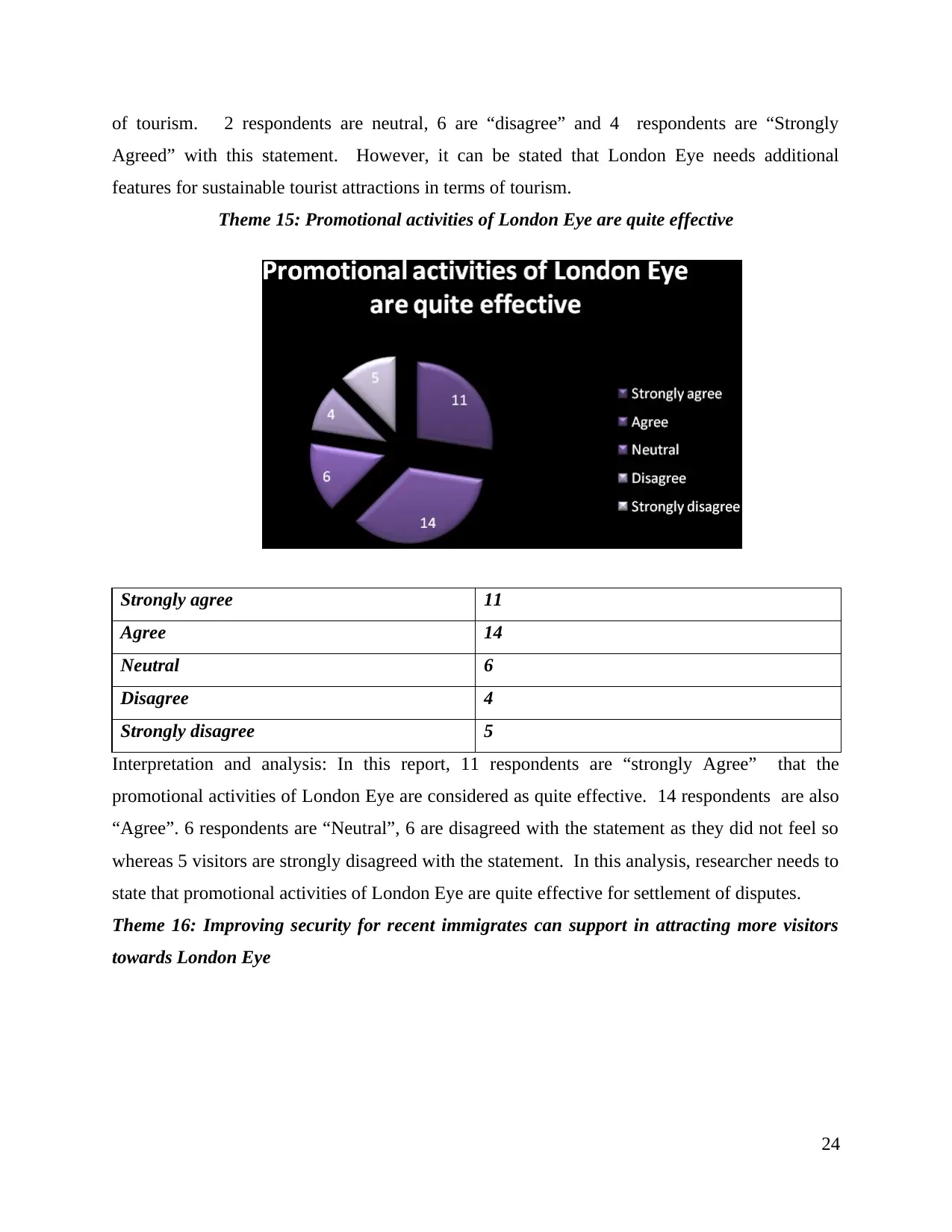
of tourism. 2 respondents are neutral, 6 are “disagree” and 4 respondents are “Strongly
Agreed” with this statement. However, it can be stated that London Eye needs additional
features for sustainable tourist attractions in terms of tourism.
Theme 15: Promotional activities of London Eye are quite effective
Strongly agree 11
Agree 14
Neutral 6
Disagree 4
Strongly disagree 5
Interpretation and analysis: In this report, 11 respondents are “strongly Agree” that the
promotional activities of London Eye are considered as quite effective. 14 respondents are also
“Agree”. 6 respondents are “Neutral”, 6 are disagreed with the statement as they did not feel so
whereas 5 visitors are strongly disagreed with the statement. In this analysis, researcher needs to
state that promotional activities of London Eye are quite effective for settlement of disputes.
Theme 16: Improving security for recent immigrates can support in attracting more visitors
towards London Eye
24
Agreed” with this statement. However, it can be stated that London Eye needs additional
features for sustainable tourist attractions in terms of tourism.
Theme 15: Promotional activities of London Eye are quite effective
Strongly agree 11
Agree 14
Neutral 6
Disagree 4
Strongly disagree 5
Interpretation and analysis: In this report, 11 respondents are “strongly Agree” that the
promotional activities of London Eye are considered as quite effective. 14 respondents are also
“Agree”. 6 respondents are “Neutral”, 6 are disagreed with the statement as they did not feel so
whereas 5 visitors are strongly disagreed with the statement. In this analysis, researcher needs to
state that promotional activities of London Eye are quite effective for settlement of disputes.
Theme 16: Improving security for recent immigrates can support in attracting more visitors
towards London Eye
24

Agree 32
Disagree 8
Interpretation and analysis: In this research, survey has been conducted by researcher
using questionnaire method. From the sample of 40 visitors, 32 respondents are “Agree” as they
feel that improvement in security for recent immigrants provide support in attracting more
visitors. Remaining 8 respondents are “Disagree”. Which is considered as important part of
research. However, it can be stated that digital technology has provided support in completion of
research.
Theme 17: climate condition influences the mind of visitors
25
Disagree 8
Interpretation and analysis: In this research, survey has been conducted by researcher
using questionnaire method. From the sample of 40 visitors, 32 respondents are “Agree” as they
feel that improvement in security for recent immigrants provide support in attracting more
visitors. Remaining 8 respondents are “Disagree”. Which is considered as important part of
research. However, it can be stated that digital technology has provided support in completion of
research.
Theme 17: climate condition influences the mind of visitors
25
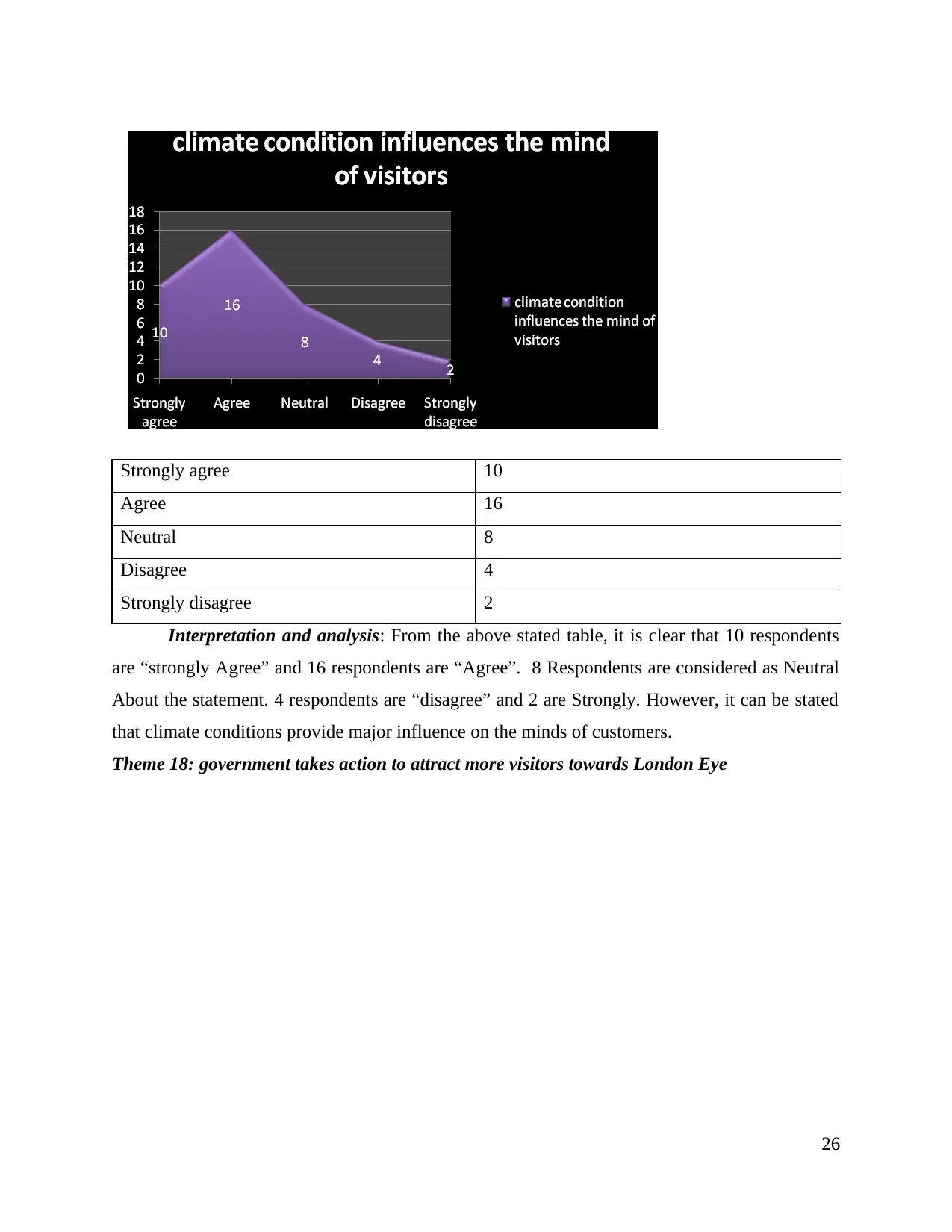
Strongly agree 10
Agree 16
Neutral 8
Disagree 4
Strongly disagree 2
Interpretation and analysis: From the above stated table, it is clear that 10 respondents
are “strongly Agree” and 16 respondents are “Agree”. 8 Respondents are considered as Neutral
About the statement. 4 respondents are “disagree” and 2 are Strongly. However, it can be stated
that climate conditions provide major influence on the minds of customers.
Theme 18: government takes action to attract more visitors towards London Eye
26
Agree 16
Neutral 8
Disagree 4
Strongly disagree 2
Interpretation and analysis: From the above stated table, it is clear that 10 respondents
are “strongly Agree” and 16 respondents are “Agree”. 8 Respondents are considered as Neutral
About the statement. 4 respondents are “disagree” and 2 are Strongly. However, it can be stated
that climate conditions provide major influence on the minds of customers.
Theme 18: government takes action to attract more visitors towards London Eye
26
Secure Best Marks with AI Grader
Need help grading? Try our AI Grader for instant feedback on your assignments.
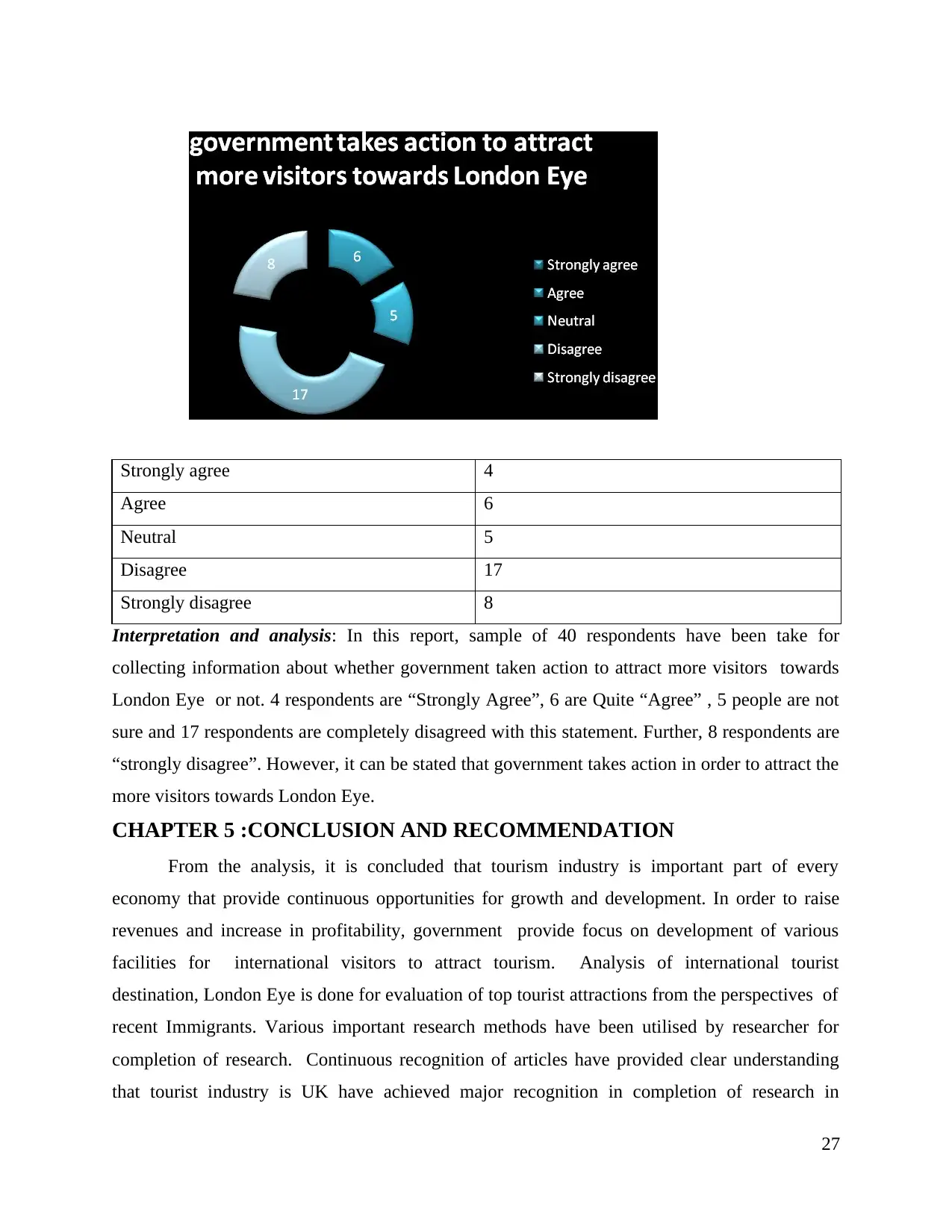
Strongly agree 4
Agree 6
Neutral 5
Disagree 17
Strongly disagree 8
Interpretation and analysis: In this report, sample of 40 respondents have been take for
collecting information about whether government taken action to attract more visitors towards
London Eye or not. 4 respondents are “Strongly Agree”, 6 are Quite “Agree” , 5 people are not
sure and 17 respondents are completely disagreed with this statement. Further, 8 respondents are
“strongly disagree”. However, it can be stated that government takes action in order to attract the
more visitors towards London Eye.
CHAPTER 5 :CONCLUSION AND RECOMMENDATION
From the analysis, it is concluded that tourism industry is important part of every
economy that provide continuous opportunities for growth and development. In order to raise
revenues and increase in profitability, government provide focus on development of various
facilities for international visitors to attract tourism. Analysis of international tourist
destination, London Eye is done for evaluation of top tourist attractions from the perspectives of
recent Immigrants. Various important research methods have been utilised by researcher for
completion of research. Continuous recognition of articles have provided clear understanding
that tourist industry is UK have achieved major recognition in completion of research in
27
Agree 6
Neutral 5
Disagree 17
Strongly disagree 8
Interpretation and analysis: In this report, sample of 40 respondents have been take for
collecting information about whether government taken action to attract more visitors towards
London Eye or not. 4 respondents are “Strongly Agree”, 6 are Quite “Agree” , 5 people are not
sure and 17 respondents are completely disagreed with this statement. Further, 8 respondents are
“strongly disagree”. However, it can be stated that government takes action in order to attract the
more visitors towards London Eye.
CHAPTER 5 :CONCLUSION AND RECOMMENDATION
From the analysis, it is concluded that tourism industry is important part of every
economy that provide continuous opportunities for growth and development. In order to raise
revenues and increase in profitability, government provide focus on development of various
facilities for international visitors to attract tourism. Analysis of international tourist
destination, London Eye is done for evaluation of top tourist attractions from the perspectives of
recent Immigrants. Various important research methods have been utilised by researcher for
completion of research. Continuous recognition of articles have provided clear understanding
that tourist industry is UK have achieved major recognition in completion of research in
27

appropriate manner. Important research methods have been utilized by researcher for
completion of research in appropriate manner. Utilization of interpretivism philosophy has
provided major support in accomplishment of aims and objectives. This aids in qualitative
research which involves analysis and interpretation of questionnaire through which data has been
collected in this method. Further, utilization of descriptive research design has provided a clear
direction for completion research. Above analysis provided clear understanding that London
eye needs additional features for sustainable attraction in terms of tourism. Tour operators and
government need to provide focus on taking effective measures for adding features to attract
international visitors. Changes in facilities like transportation, attraction accomodation and other
cultural thing msut be developed in order influence international immigrants. Conference halls
can also developed for attraction corporate visitors or business man who are likely to tourist
destination for their meetings.
In addition, data analysis provides clear understanding that expenditure of international
visitors in London Eye is increased and they have spend money between £45-£55. This increase
expenditure of visitors provide positive influence on the growth of tourist destination and other
local communities associated with tourism sector. It was also analysed that Visitors are satisfied
with their most recent visit to London Eye. Amount of questionnaire has been completed by
various important researcher in completion of research in appropriate manner. Although, visitors
have also viewed that the government of UK have also taken various inititives to make london
eye as major tourist destination. They have continuously provided support to the strategies made
by tour operators for increasing international and number of immigrants from another countries.
In London Eye, government and tourism authorities have provided major focus on providing
proper care and safety for immigrants at tourist destination.
Along with this, increase in number of tourist attraction in London eye also tends to
provide influence of perception of visitors to arrive at those places. Visitors are also satisfied
with the travelling facilities which are available at tourist destination. They have also stated that
tourism services in London are also provided to customers as per standards which are provided
by government. Proper and health environment at tourist destination tends to increase the
standards of London Eye as international tourist destination. Continuous increase in tourism
service providers have also provided major supports in completion of research and analysis of
various facts and figures.
28
completion of research in appropriate manner. Utilization of interpretivism philosophy has
provided major support in accomplishment of aims and objectives. This aids in qualitative
research which involves analysis and interpretation of questionnaire through which data has been
collected in this method. Further, utilization of descriptive research design has provided a clear
direction for completion research. Above analysis provided clear understanding that London
eye needs additional features for sustainable attraction in terms of tourism. Tour operators and
government need to provide focus on taking effective measures for adding features to attract
international visitors. Changes in facilities like transportation, attraction accomodation and other
cultural thing msut be developed in order influence international immigrants. Conference halls
can also developed for attraction corporate visitors or business man who are likely to tourist
destination for their meetings.
In addition, data analysis provides clear understanding that expenditure of international
visitors in London Eye is increased and they have spend money between £45-£55. This increase
expenditure of visitors provide positive influence on the growth of tourist destination and other
local communities associated with tourism sector. It was also analysed that Visitors are satisfied
with their most recent visit to London Eye. Amount of questionnaire has been completed by
various important researcher in completion of research in appropriate manner. Although, visitors
have also viewed that the government of UK have also taken various inititives to make london
eye as major tourist destination. They have continuously provided support to the strategies made
by tour operators for increasing international and number of immigrants from another countries.
In London Eye, government and tourism authorities have provided major focus on providing
proper care and safety for immigrants at tourist destination.
Along with this, increase in number of tourist attraction in London eye also tends to
provide influence of perception of visitors to arrive at those places. Visitors are also satisfied
with the travelling facilities which are available at tourist destination. They have also stated that
tourism services in London are also provided to customers as per standards which are provided
by government. Proper and health environment at tourist destination tends to increase the
standards of London Eye as international tourist destination. Continuous increase in tourism
service providers have also provided major supports in completion of research and analysis of
various facts and figures.
28
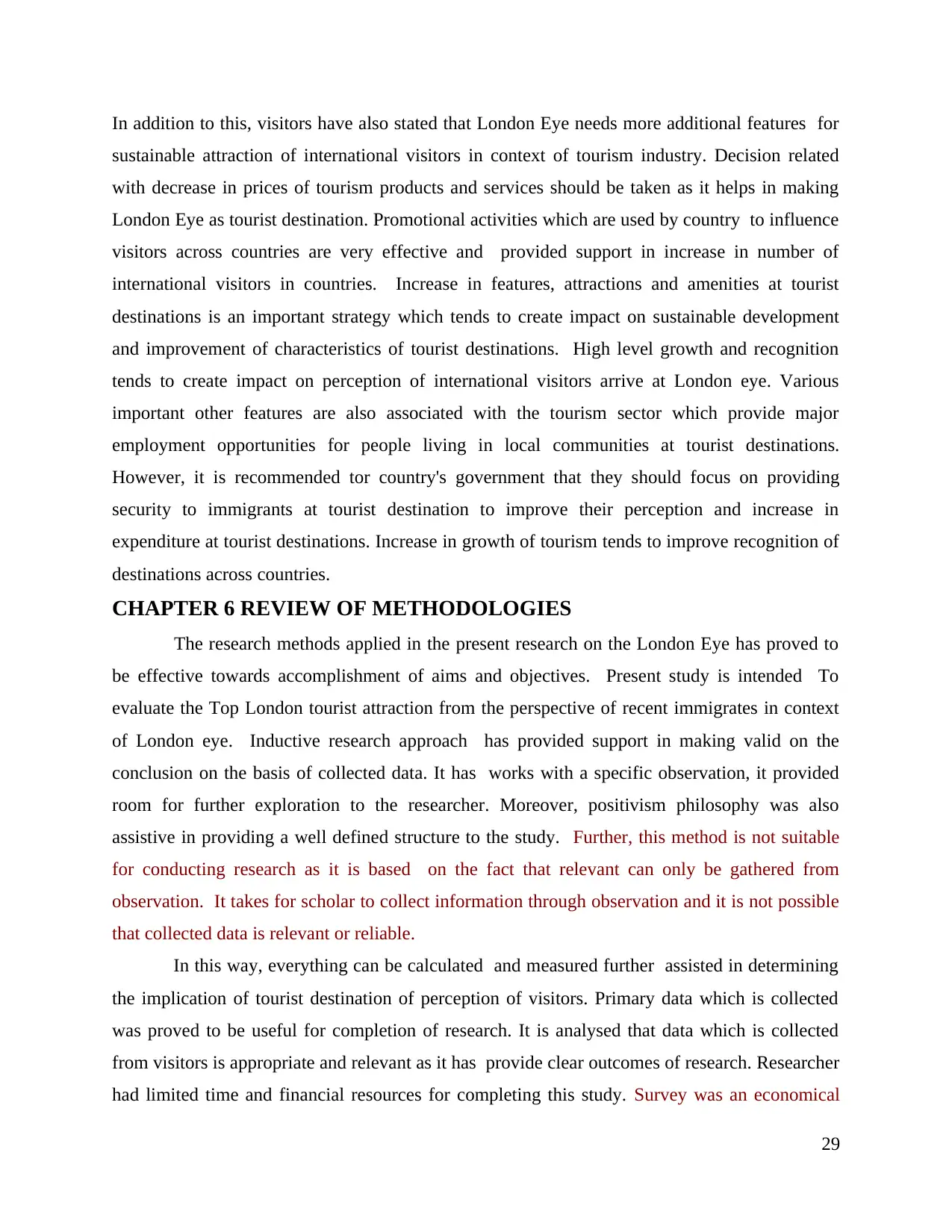
In addition to this, visitors have also stated that London Eye needs more additional features for
sustainable attraction of international visitors in context of tourism industry. Decision related
with decrease in prices of tourism products and services should be taken as it helps in making
London Eye as tourist destination. Promotional activities which are used by country to influence
visitors across countries are very effective and provided support in increase in number of
international visitors in countries. Increase in features, attractions and amenities at tourist
destinations is an important strategy which tends to create impact on sustainable development
and improvement of characteristics of tourist destinations. High level growth and recognition
tends to create impact on perception of international visitors arrive at London eye. Various
important other features are also associated with the tourism sector which provide major
employment opportunities for people living in local communities at tourist destinations.
However, it is recommended tor country's government that they should focus on providing
security to immigrants at tourist destination to improve their perception and increase in
expenditure at tourist destinations. Increase in growth of tourism tends to improve recognition of
destinations across countries.
CHAPTER 6 REVIEW OF METHODOLOGIES
The research methods applied in the present research on the London Eye has proved to
be effective towards accomplishment of aims and objectives. Present study is intended To
evaluate the Top London tourist attraction from the perspective of recent immigrates in context
of London eye. Inductive research approach has provided support in making valid on the
conclusion on the basis of collected data. It has works with a specific observation, it provided
room for further exploration to the researcher. Moreover, positivism philosophy was also
assistive in providing a well defined structure to the study. Further, this method is not suitable
for conducting research as it is based on the fact that relevant can only be gathered from
observation. It takes for scholar to collect information through observation and it is not possible
that collected data is relevant or reliable.
In this way, everything can be calculated and measured further assisted in determining
the implication of tourist destination of perception of visitors. Primary data which is collected
was proved to be useful for completion of research. It is analysed that data which is collected
from visitors is appropriate and relevant as it has provide clear outcomes of research. Researcher
had limited time and financial resources for completing this study. Survey was an economical
29
sustainable attraction of international visitors in context of tourism industry. Decision related
with decrease in prices of tourism products and services should be taken as it helps in making
London Eye as tourist destination. Promotional activities which are used by country to influence
visitors across countries are very effective and provided support in increase in number of
international visitors in countries. Increase in features, attractions and amenities at tourist
destinations is an important strategy which tends to create impact on sustainable development
and improvement of characteristics of tourist destinations. High level growth and recognition
tends to create impact on perception of international visitors arrive at London eye. Various
important other features are also associated with the tourism sector which provide major
employment opportunities for people living in local communities at tourist destinations.
However, it is recommended tor country's government that they should focus on providing
security to immigrants at tourist destination to improve their perception and increase in
expenditure at tourist destinations. Increase in growth of tourism tends to improve recognition of
destinations across countries.
CHAPTER 6 REVIEW OF METHODOLOGIES
The research methods applied in the present research on the London Eye has proved to
be effective towards accomplishment of aims and objectives. Present study is intended To
evaluate the Top London tourist attraction from the perspective of recent immigrates in context
of London eye. Inductive research approach has provided support in making valid on the
conclusion on the basis of collected data. It has works with a specific observation, it provided
room for further exploration to the researcher. Moreover, positivism philosophy was also
assistive in providing a well defined structure to the study. Further, this method is not suitable
for conducting research as it is based on the fact that relevant can only be gathered from
observation. It takes for scholar to collect information through observation and it is not possible
that collected data is relevant or reliable.
In this way, everything can be calculated and measured further assisted in determining
the implication of tourist destination of perception of visitors. Primary data which is collected
was proved to be useful for completion of research. It is analysed that data which is collected
from visitors is appropriate and relevant as it has provide clear outcomes of research. Researcher
had limited time and financial resources for completing this study. Survey was an economical
29
Paraphrase This Document
Need a fresh take? Get an instant paraphrase of this document with our AI Paraphraser

method of collecting primary data and also helped in saving time that is consumed during data
collection. However, framing questionnaire is difficult for scholar as it required skills and
experience. Researcher in this study have also faced some issues in formulation of questionnaire
and gathering data from respondents.
Collection of secondary data has provided information and helped in developing understanding
about the research. Thus, it can be said that chosen method helps in completion of study and
accomplishment of aims and objectives.
CHAPTER 7 :REFLECTION
I have learned lot new things and have discovered important facts about the tourism. I
have able to develop understanding about various research approaches as well as techniques. By
participating in investigation process. I have learned about the formal structure of research
project. I have gained knowledge about the systematic procedure which is required to be
followed by an individual in order to conduct research in systematic manner. I have successfully
identified the barriers as well as issues which might occur in facilitating the study. I have access
the different types of risk which are required to be considered by me or researcher when making
a plan. I have learned that success of research project is completed based on the way in which
the several activities are executed and on the sources from where the information has been
gathered.
I have learned about different types of sampling method like random, stratified sampling,
cluster, systematic and multi sage sampling. I have utilized this method in my research paper it is
very helpful for me. I have developed the understanding about the techniques or methods which
can be used by me for accumulating the facts relevant to research topic. I believe that it is
strength of research that all the decisions are taken on the basis of evidence. I have used the
several tools as well as instrument for measuring the reliability of information. As Due to the
lack of effective communication skill I have faced difficulty in conducting interview.
Considering this factor I have decided to appoint the expert person for collecting the information
directly from participants. In addition to this due to lack of knowledge about research
methodologies I have faced the much difficulty in executing the investigation in detail. Due I
also faced difficulty in searching the much information about the topic. During the executing the
researcher procedure I have been provided by regular instruction and feedback by Tutor which
has assisted me in completing the project in successful manner. In research project I found
30
collection. However, framing questionnaire is difficult for scholar as it required skills and
experience. Researcher in this study have also faced some issues in formulation of questionnaire
and gathering data from respondents.
Collection of secondary data has provided information and helped in developing understanding
about the research. Thus, it can be said that chosen method helps in completion of study and
accomplishment of aims and objectives.
CHAPTER 7 :REFLECTION
I have learned lot new things and have discovered important facts about the tourism. I
have able to develop understanding about various research approaches as well as techniques. By
participating in investigation process. I have learned about the formal structure of research
project. I have gained knowledge about the systematic procedure which is required to be
followed by an individual in order to conduct research in systematic manner. I have successfully
identified the barriers as well as issues which might occur in facilitating the study. I have access
the different types of risk which are required to be considered by me or researcher when making
a plan. I have learned that success of research project is completed based on the way in which
the several activities are executed and on the sources from where the information has been
gathered.
I have learned about different types of sampling method like random, stratified sampling,
cluster, systematic and multi sage sampling. I have utilized this method in my research paper it is
very helpful for me. I have developed the understanding about the techniques or methods which
can be used by me for accumulating the facts relevant to research topic. I believe that it is
strength of research that all the decisions are taken on the basis of evidence. I have used the
several tools as well as instrument for measuring the reliability of information. As Due to the
lack of effective communication skill I have faced difficulty in conducting interview.
Considering this factor I have decided to appoint the expert person for collecting the information
directly from participants. In addition to this due to lack of knowledge about research
methodologies I have faced the much difficulty in executing the investigation in detail. Due I
also faced difficulty in searching the much information about the topic. During the executing the
researcher procedure I have been provided by regular instruction and feedback by Tutor which
has assisted me in completing the project in successful manner. In research project I found
30
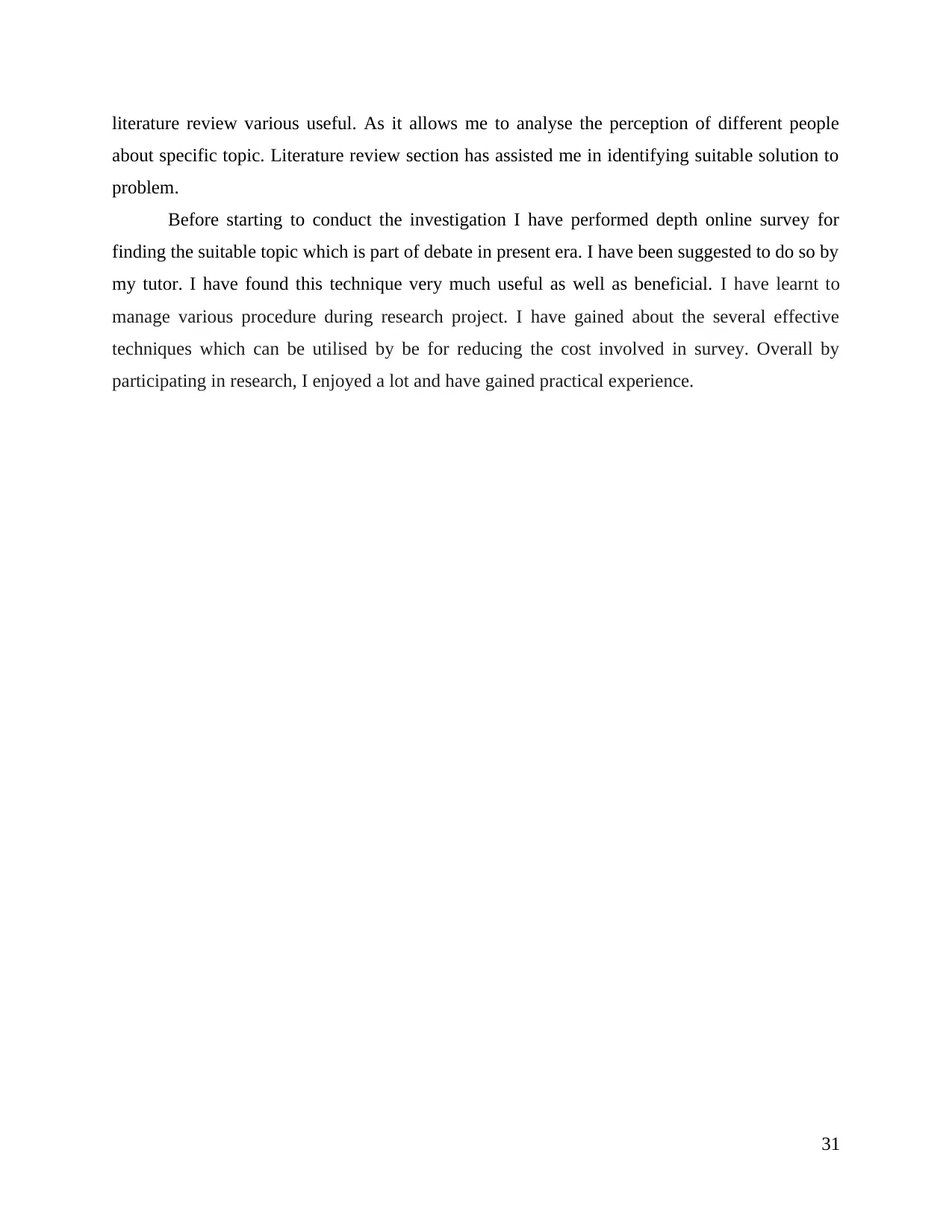
literature review various useful. As it allows me to analyse the perception of different people
about specific topic. Literature review section has assisted me in identifying suitable solution to
problem.
Before starting to conduct the investigation I have performed depth online survey for
finding the suitable topic which is part of debate in present era. I have been suggested to do so by
my tutor. I have found this technique very much useful as well as beneficial. I have learnt to
manage various procedure during research project. I have gained about the several effective
techniques which can be utilised by be for reducing the cost involved in survey. Overall by
participating in research, I enjoyed a lot and have gained practical experience.
31
about specific topic. Literature review section has assisted me in identifying suitable solution to
problem.
Before starting to conduct the investigation I have performed depth online survey for
finding the suitable topic which is part of debate in present era. I have been suggested to do so by
my tutor. I have found this technique very much useful as well as beneficial. I have learnt to
manage various procedure during research project. I have gained about the several effective
techniques which can be utilised by be for reducing the cost involved in survey. Overall by
participating in research, I enjoyed a lot and have gained practical experience.
31
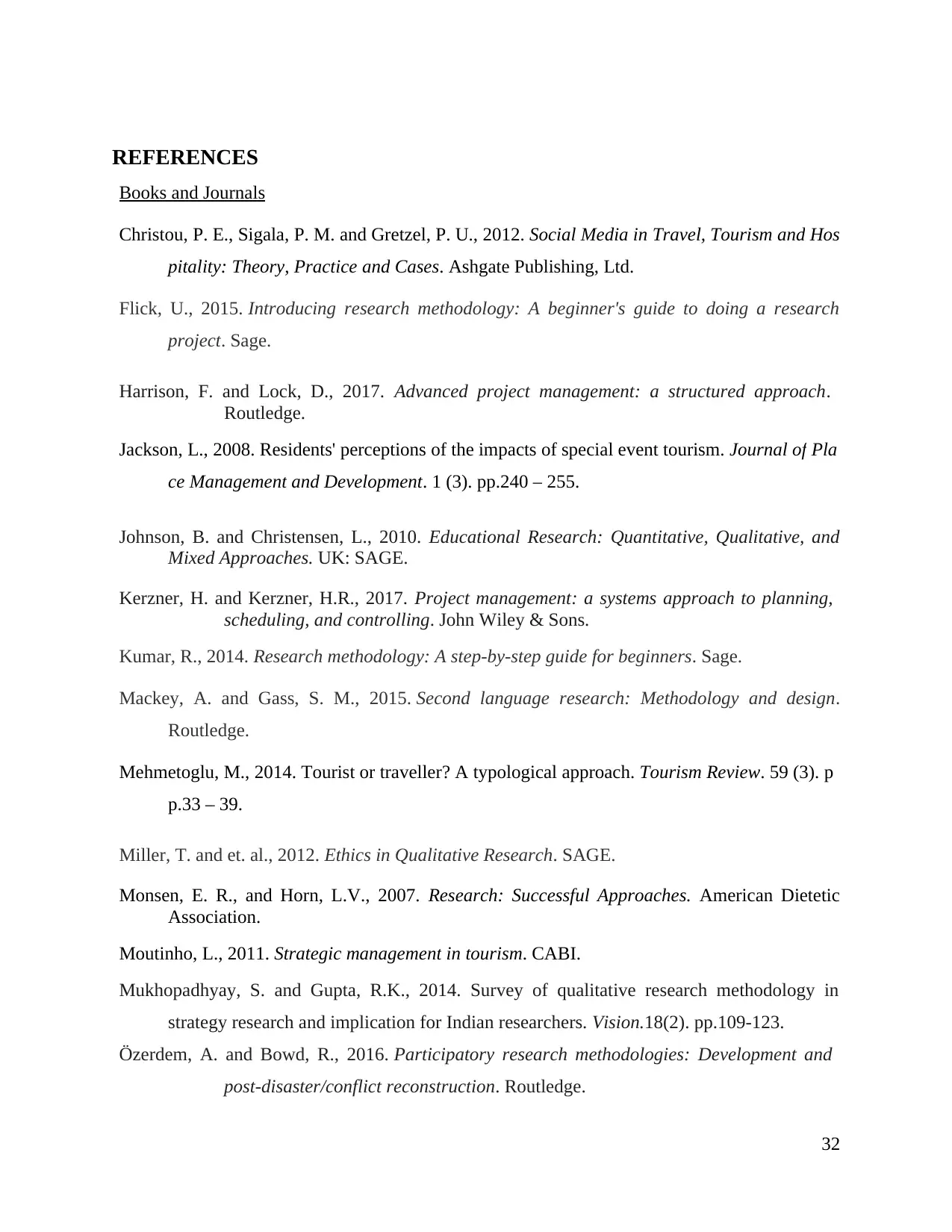
REFERENCES
Books and Journals
Christou, P. E., Sigala, P. M. and Gretzel, P. U., 2012. Social Media in Travel, Tourism and Hos
pitality: Theory, Practice and Cases. Ashgate Publishing, Ltd.
Flick, U., 2015. Introducing research methodology: A beginner's guide to doing a research
project. Sage.
Harrison, F. and Lock, D., 2017. Advanced project management: a structured approach.
Routledge.
Jackson, L., 2008. Residents' perceptions of the impacts of special event tourism. Journal of Pla
ce Management and Development. 1 (3). pp.240 – 255.
Johnson, B. and Christensen, L., 2010. Educational Research: Quantitative, Qualitative, and
Mixed Approaches. UK: SAGE.
Kerzner, H. and Kerzner, H.R., 2017. Project management: a systems approach to planning,
scheduling, and controlling. John Wiley & Sons.
Kumar, R., 2014. Research methodology: A step-by-step guide for beginners. Sage.
Mackey, A. and Gass, S. M., 2015. Second language research: Methodology and design.
Routledge.
Mehmetoglu, M., 2014. Tourist or traveller? A typological approach. Tourism Review. 59 (3). p
p.33 – 39.
Miller, T. and et. al., 2012. Ethics in Qualitative Research. SAGE.
Monsen, E. R., and Horn, L.V., 2007. Research: Successful Approaches. American Dietetic
Association.
Moutinho, L., 2011. Strategic management in tourism. CABI.
Mukhopadhyay, S. and Gupta, R.K., 2014. Survey of qualitative research methodology in
strategy research and implication for Indian researchers. Vision.18(2). pp.109-123.
Özerdem, A. and Bowd, R., 2016. Participatory research methodologies: Development and
post-disaster/conflict reconstruction. Routledge.
32
Books and Journals
Christou, P. E., Sigala, P. M. and Gretzel, P. U., 2012. Social Media in Travel, Tourism and Hos
pitality: Theory, Practice and Cases. Ashgate Publishing, Ltd.
Flick, U., 2015. Introducing research methodology: A beginner's guide to doing a research
project. Sage.
Harrison, F. and Lock, D., 2017. Advanced project management: a structured approach.
Routledge.
Jackson, L., 2008. Residents' perceptions of the impacts of special event tourism. Journal of Pla
ce Management and Development. 1 (3). pp.240 – 255.
Johnson, B. and Christensen, L., 2010. Educational Research: Quantitative, Qualitative, and
Mixed Approaches. UK: SAGE.
Kerzner, H. and Kerzner, H.R., 2017. Project management: a systems approach to planning,
scheduling, and controlling. John Wiley & Sons.
Kumar, R., 2014. Research methodology: A step-by-step guide for beginners. Sage.
Mackey, A. and Gass, S. M., 2015. Second language research: Methodology and design.
Routledge.
Mehmetoglu, M., 2014. Tourist or traveller? A typological approach. Tourism Review. 59 (3). p
p.33 – 39.
Miller, T. and et. al., 2012. Ethics in Qualitative Research. SAGE.
Monsen, E. R., and Horn, L.V., 2007. Research: Successful Approaches. American Dietetic
Association.
Moutinho, L., 2011. Strategic management in tourism. CABI.
Mukhopadhyay, S. and Gupta, R.K., 2014. Survey of qualitative research methodology in
strategy research and implication for Indian researchers. Vision.18(2). pp.109-123.
Özerdem, A. and Bowd, R., 2016. Participatory research methodologies: Development and
post-disaster/conflict reconstruction. Routledge.
32
Secure Best Marks with AI Grader
Need help grading? Try our AI Grader for instant feedback on your assignments.
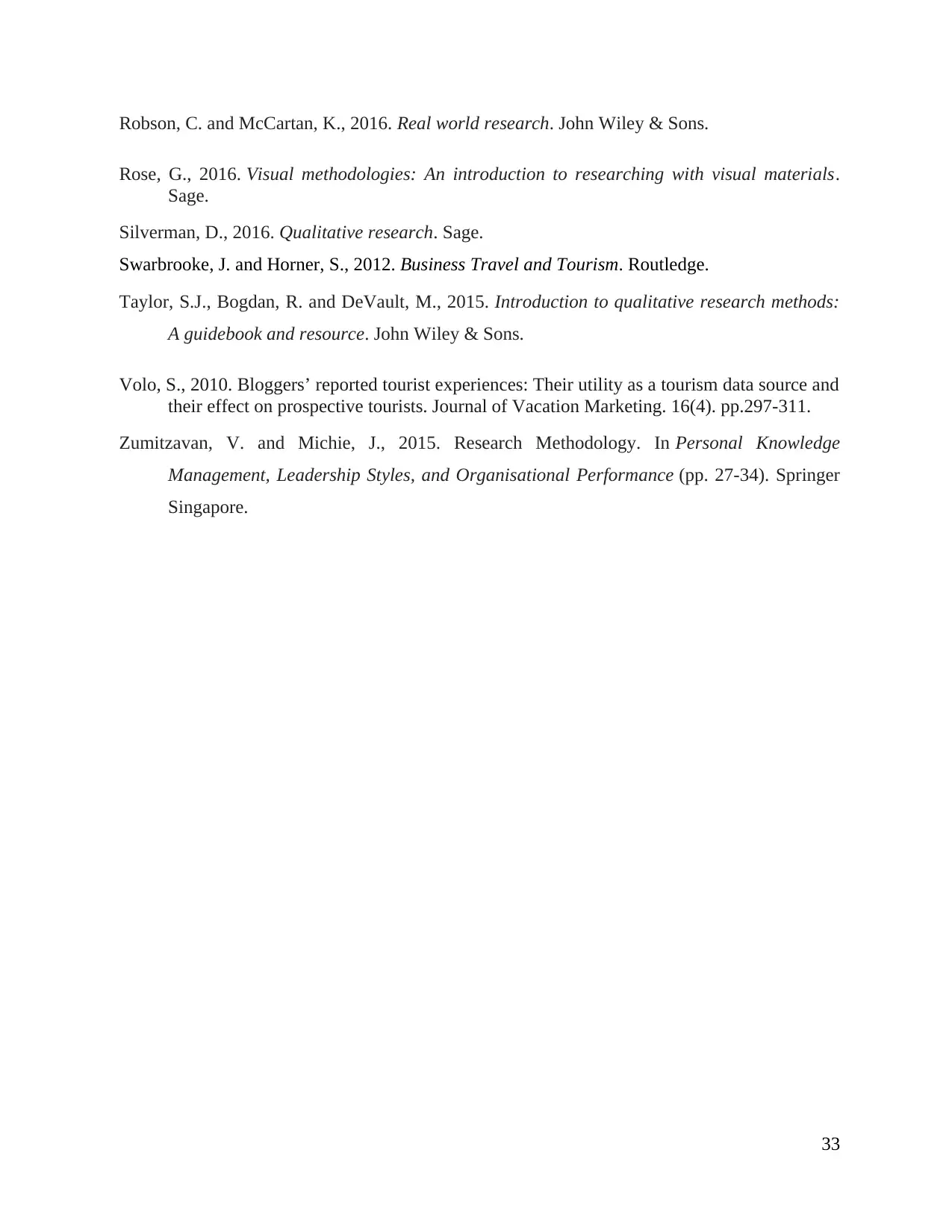
Robson, C. and McCartan, K., 2016. Real world research. John Wiley & Sons.
Rose, G., 2016. Visual methodologies: An introduction to researching with visual materials.
Sage.
Silverman, D., 2016. Qualitative research. Sage.
Swarbrooke, J. and Horner, S., 2012. Business Travel and Tourism. Routledge.
Taylor, S.J., Bogdan, R. and DeVault, M., 2015. Introduction to qualitative research methods:
A guidebook and resource. John Wiley & Sons.
Volo, S., 2010. Bloggers’ reported tourist experiences: Their utility as a tourism data source and
their effect on prospective tourists. Journal of Vacation Marketing. 16(4). pp.297-311.
Zumitzavan, V. and Michie, J., 2015. Research Methodology. In Personal Knowledge
Management, Leadership Styles, and Organisational Performance (pp. 27-34). Springer
Singapore.
33
Rose, G., 2016. Visual methodologies: An introduction to researching with visual materials.
Sage.
Silverman, D., 2016. Qualitative research. Sage.
Swarbrooke, J. and Horner, S., 2012. Business Travel and Tourism. Routledge.
Taylor, S.J., Bogdan, R. and DeVault, M., 2015. Introduction to qualitative research methods:
A guidebook and resource. John Wiley & Sons.
Volo, S., 2010. Bloggers’ reported tourist experiences: Their utility as a tourism data source and
their effect on prospective tourists. Journal of Vacation Marketing. 16(4). pp.297-311.
Zumitzavan, V. and Michie, J., 2015. Research Methodology. In Personal Knowledge
Management, Leadership Styles, and Organisational Performance (pp. 27-34). Springer
Singapore.
33
1 out of 35
Related Documents
Your All-in-One AI-Powered Toolkit for Academic Success.
+13062052269
info@desklib.com
Available 24*7 on WhatsApp / Email
![[object Object]](/_next/static/media/star-bottom.7253800d.svg)
Unlock your academic potential
© 2024 | Zucol Services PVT LTD | All rights reserved.





